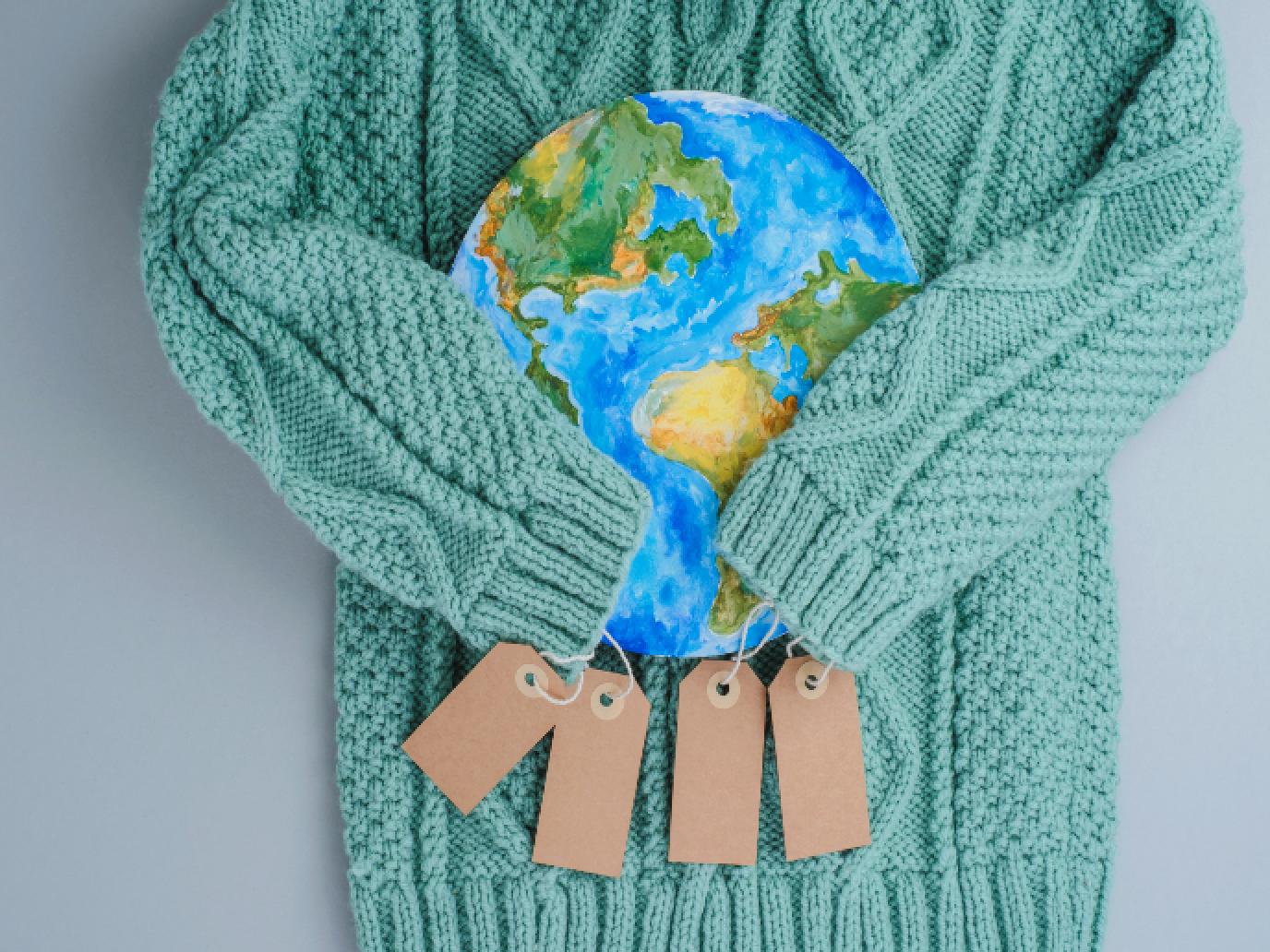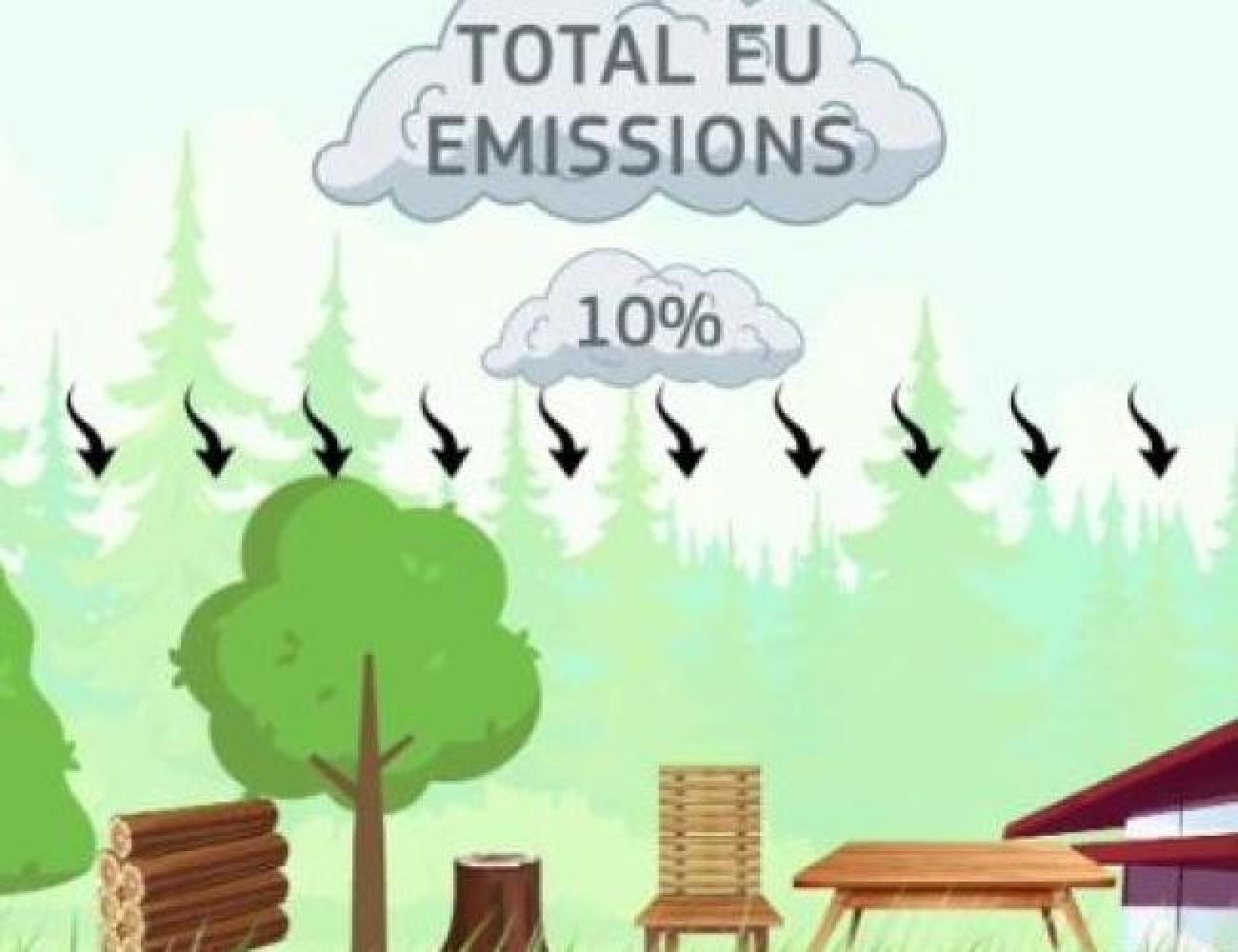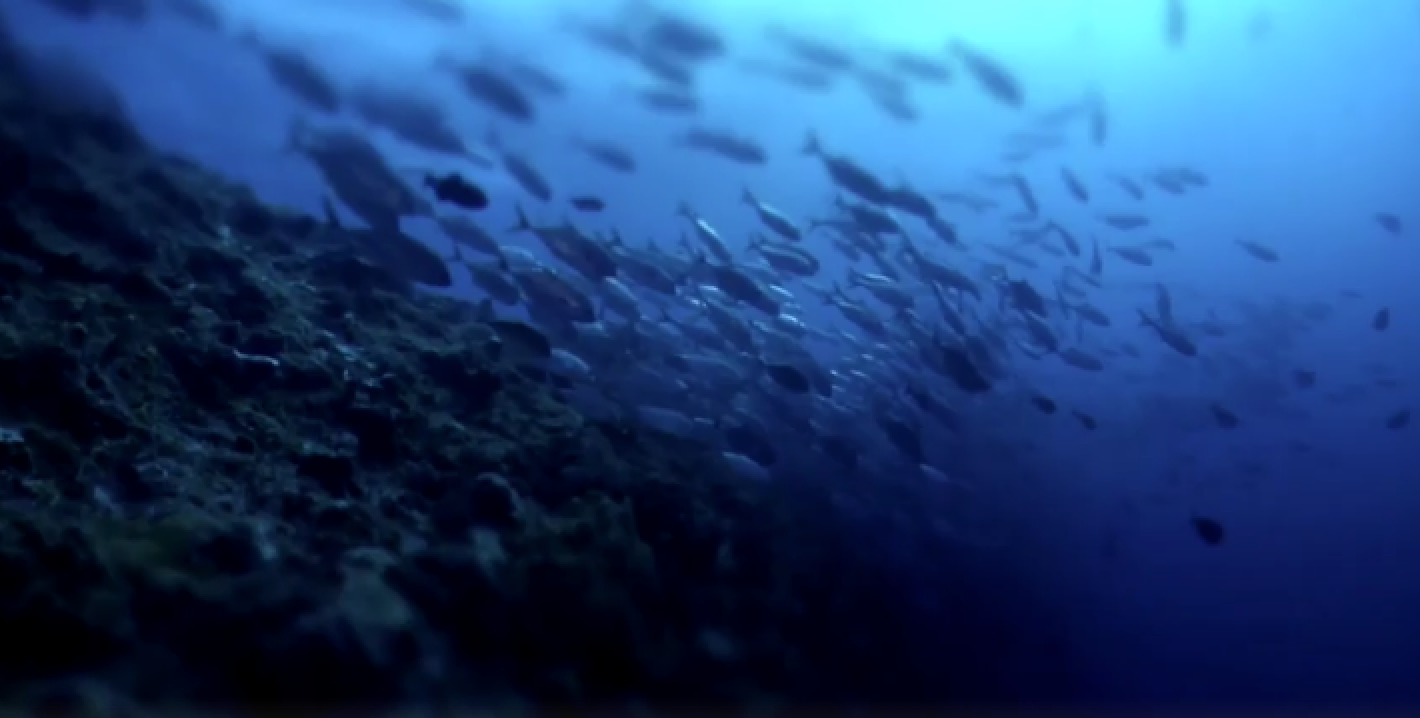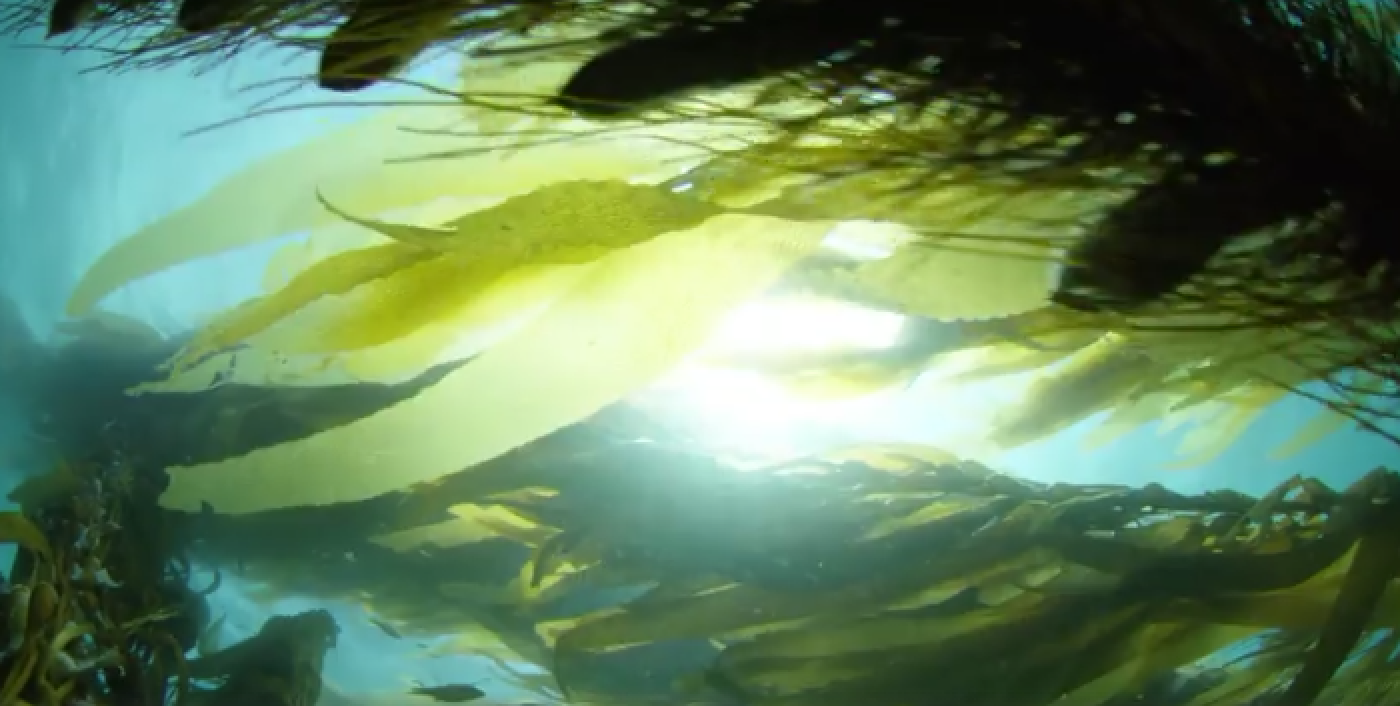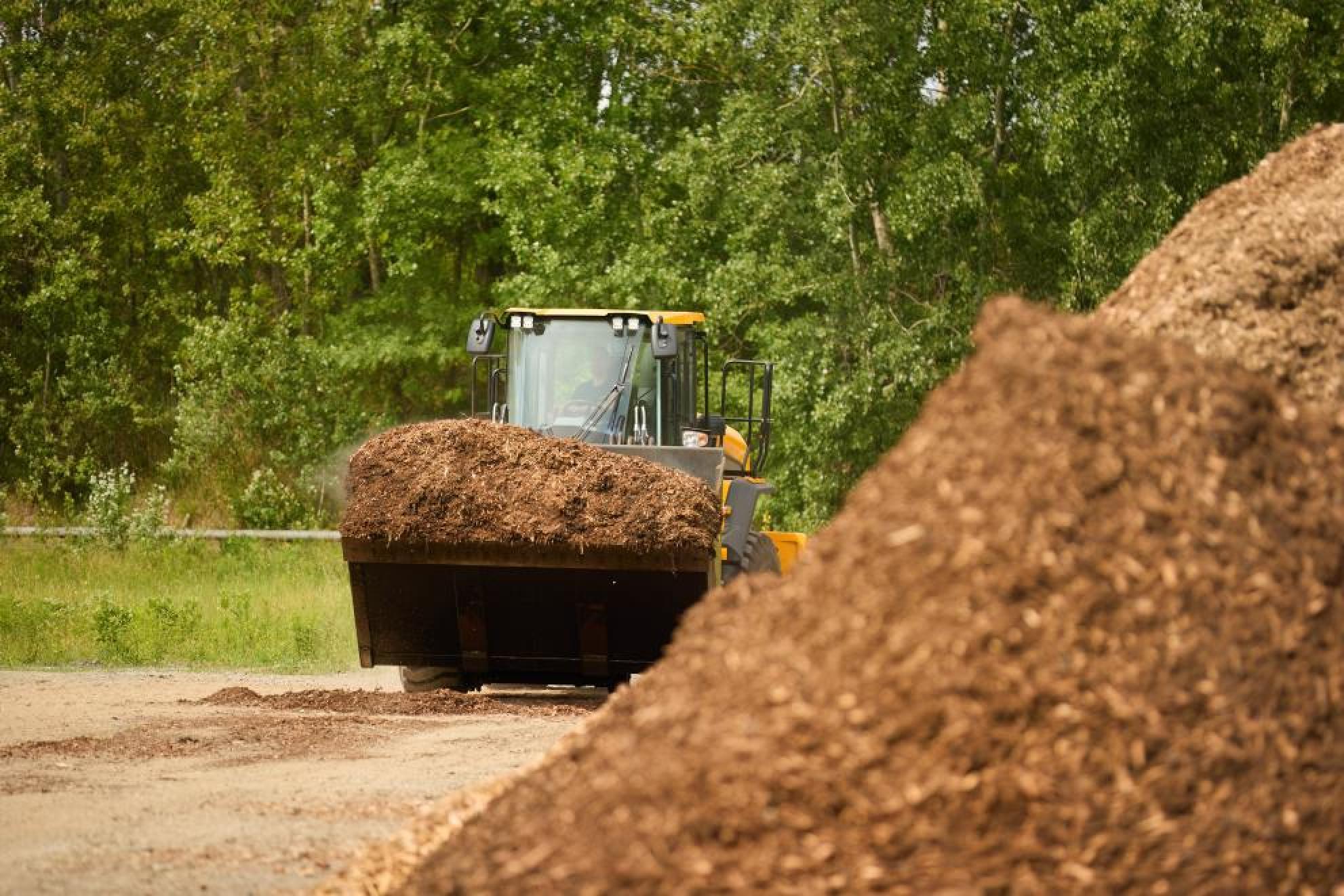KCB Science for Policy briefs
KCB selected publications
Expand the tabs to explore publications contributing to the KCB knowledge base of that year.
See all JRC publications from 2025

This annual report, presented in a new layout, provides a thorough overview of the scale and breadth of the Blue Economy within the European Union (EU). Its primary aim is to offer guidance to policymakers and stakeholders in fostering the growth of ocean-based and maritime-related markets and the sustainable use of coastal and marine resources.
- Date released: 2025/05/19

This report explores the epistemic and methodological foundations of the Integrated Bioeconomy Land Use Assessment (IBLUA) project, in which an innovative deliberation support system is developed toward more informed discussion over bioeconomy futures in the European Union (EU). In terms of the knowledge space it delivers, integral to the support system, the project employs a biophysical approach to scientific accounting, emphasising key insights from the Multi-Scale Integrated Analysis of Societal and Ecosystem Metabolism (MuSIASEM) framework, among other frameworks.
- Date released: 2025/04/16
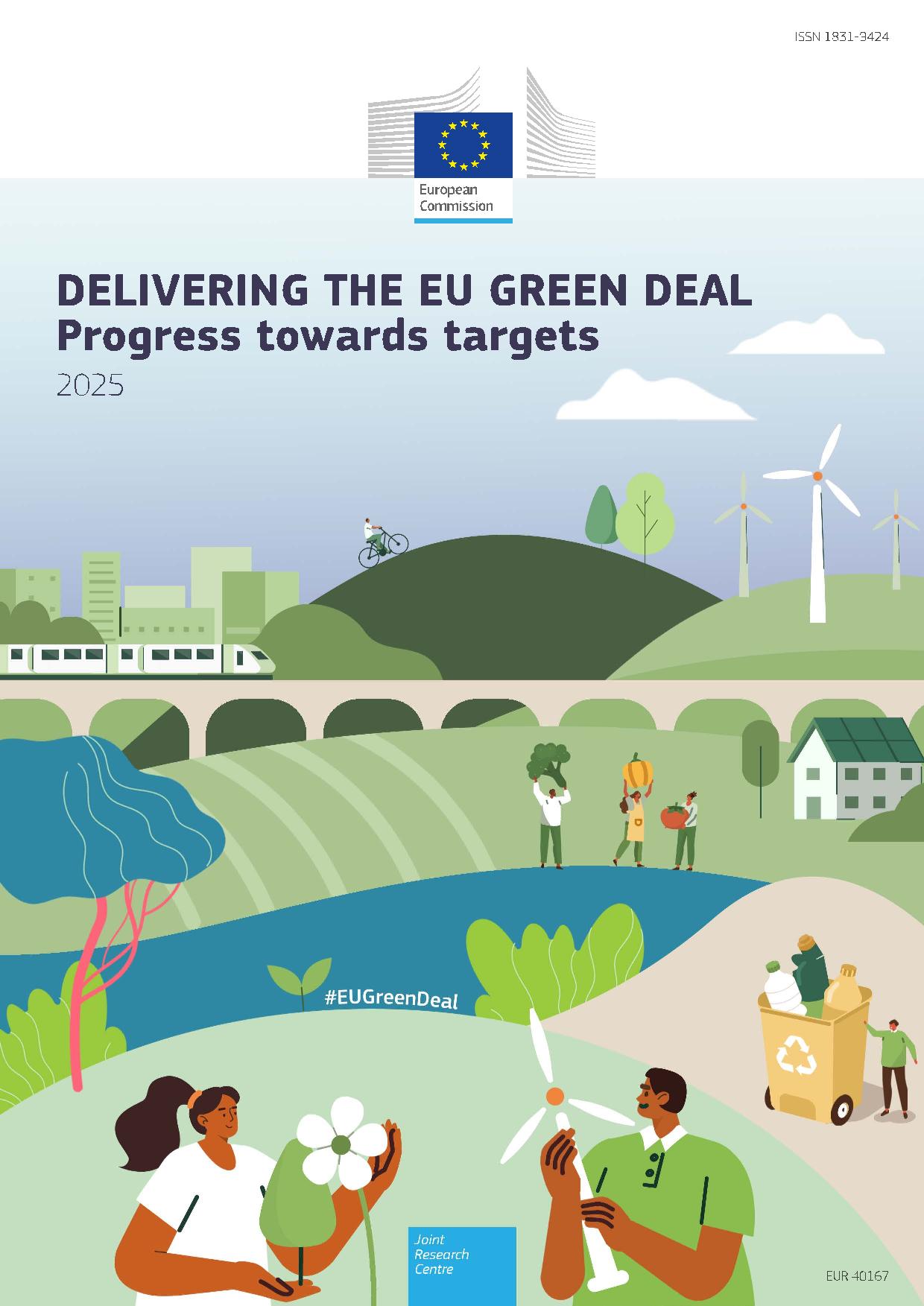
This report provides a comprehensive assessment of progress towards the European Green Deal (EGD), the European Union’s transformative agenda for achieving climate neutrality by 2050. The analysis encompasses 154 quantifiable targets from 44 policy documents between 2019 and 2024 across key sectors such as climate, energy, circular economy, transport, agriculture and food, ecosystems and biodiversity, water, soil and air pollution.
- Date released: 2025/01/30
See all JRC publications from 2024

This study maps progress towards the five objectives of the EU Bioeconomy Strategy. It detects notable improvements in ensuring food and nutrition security, reducing dependence on non-renewable resources with substitution by bio-base sources, and strengthening European competitiveness and creating jobs. However, the challenges in managing natural resources sustainably and mitigating and adapting to climate change persist.
- Date released: 2024/11/29
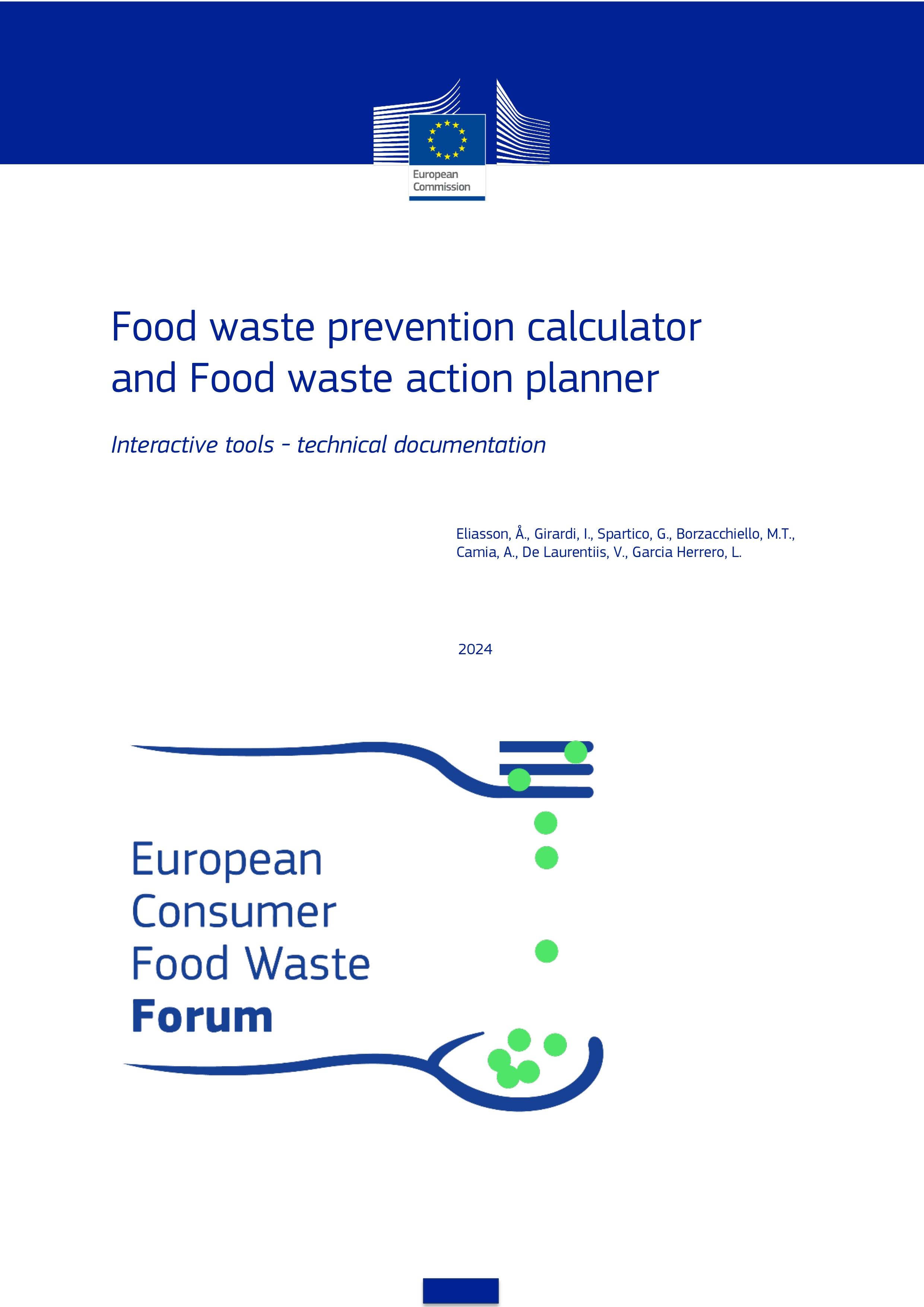
This report describes the technical properties of two web applications developed by the Joint Research Centre in collaboration with the Directorate-General for Health and Food Safety and the European Consumer Food Waste Forum. The web applications are part of the Toolkit to reduce consumer food waste, which were created and maintained by the Knowledge Centre for Bioeconomy for use on the European Commission’s Knowledge4Policy platform.
- Date released: 2024/11/29
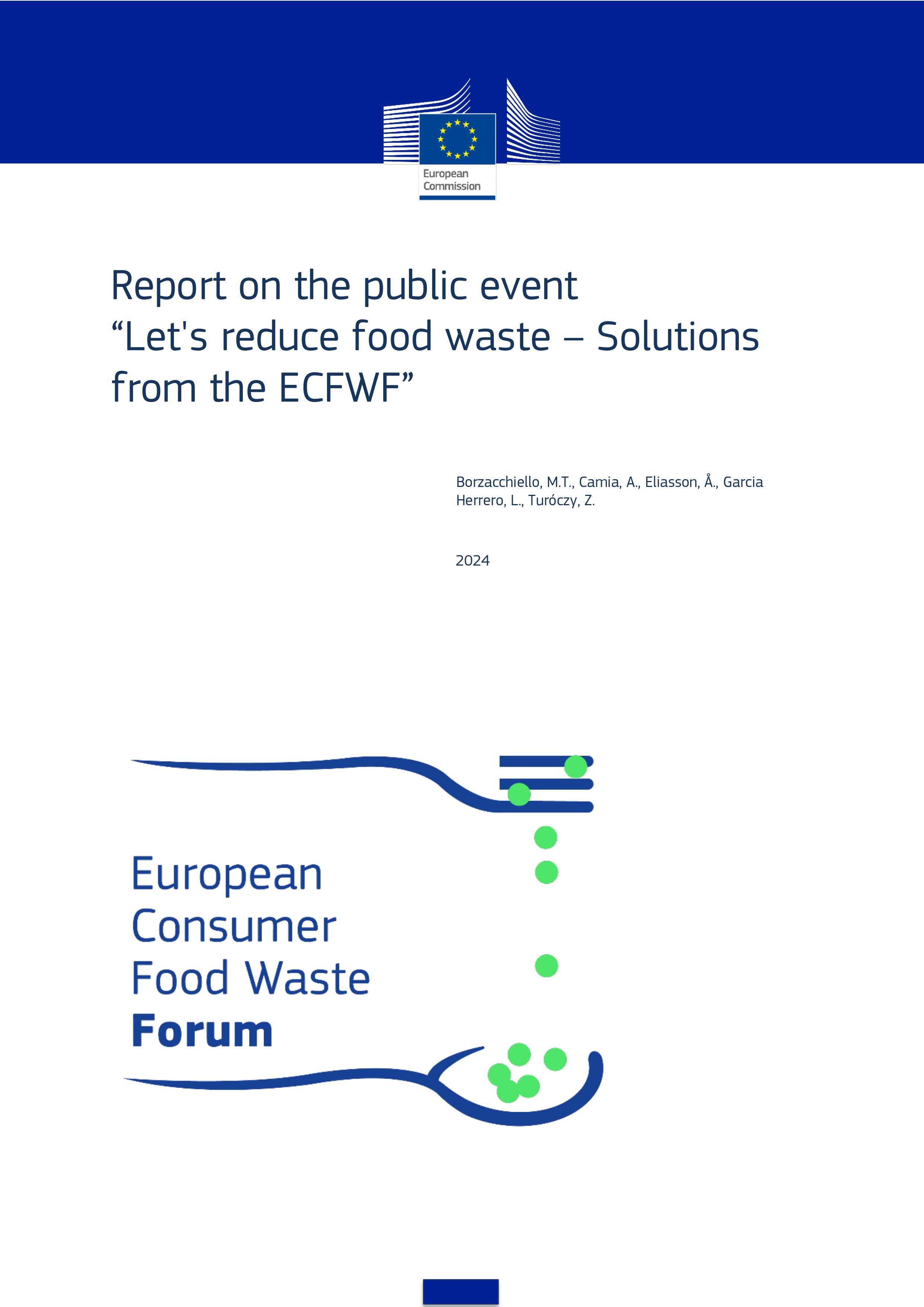
The public event "Let's reduce consumer food waste! Solutions from the European Consumer Food Waste Forum" was held on 5 June 2024 in Brussels. Organised by the European Commission’s Knowledge Centre for Bioeconomy and Directorate-General for Health and Food Safety, the hybrid conference brought together 150 key stakeholders onsite and further 300 online, from both public and private sector; from local, regional and national authorities.
- Date released: 2024/11/29

This report summarises the results of a scientific game on bioeconomy which engaged several stakeholders across EU in foresight thinking. The analysis of the dynamics and discussions during the workshops revealed that collaboration among bioeconomy actors is considered as instrumental for success, taking into account the importance of different perspectives and of shared but clear responsibilities. The exemplary actions were found to be collaboration, funding, knowledge sharing and communication, actions with a regional and rural focus and inclusive actions to reach left-behind societal groups. The findings from the workshops have been used as a basis to formulate policy implications that could contribute to the policy debate on the bioeconomy.
- Date released: 2024/01/12
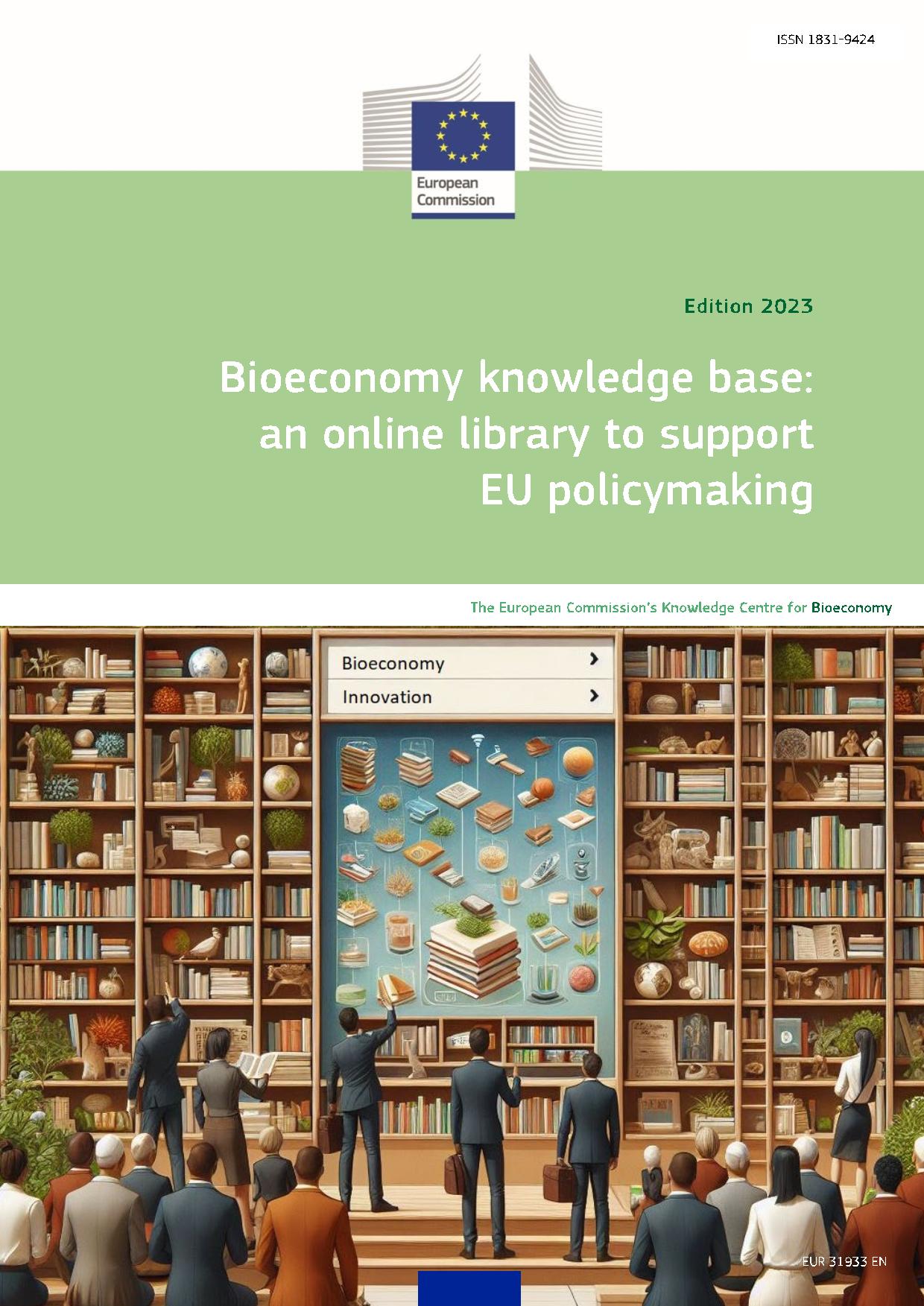
The Knowledge Centre for Bioeconomy (KCB) aims to enhance the knowledge base on the bioeconomy to contribute to better policymaking. As of 2023, the KCB library contained more than 5600 curated resources, constantly updated with the latest publications, datasets, events, news. This report desribes the workflow process and methods used in the curation task. It includes an update of the statistics until the end of 2023 and explains how recommendations from the previous report have been addressed.
- Date released: 2024/06/21
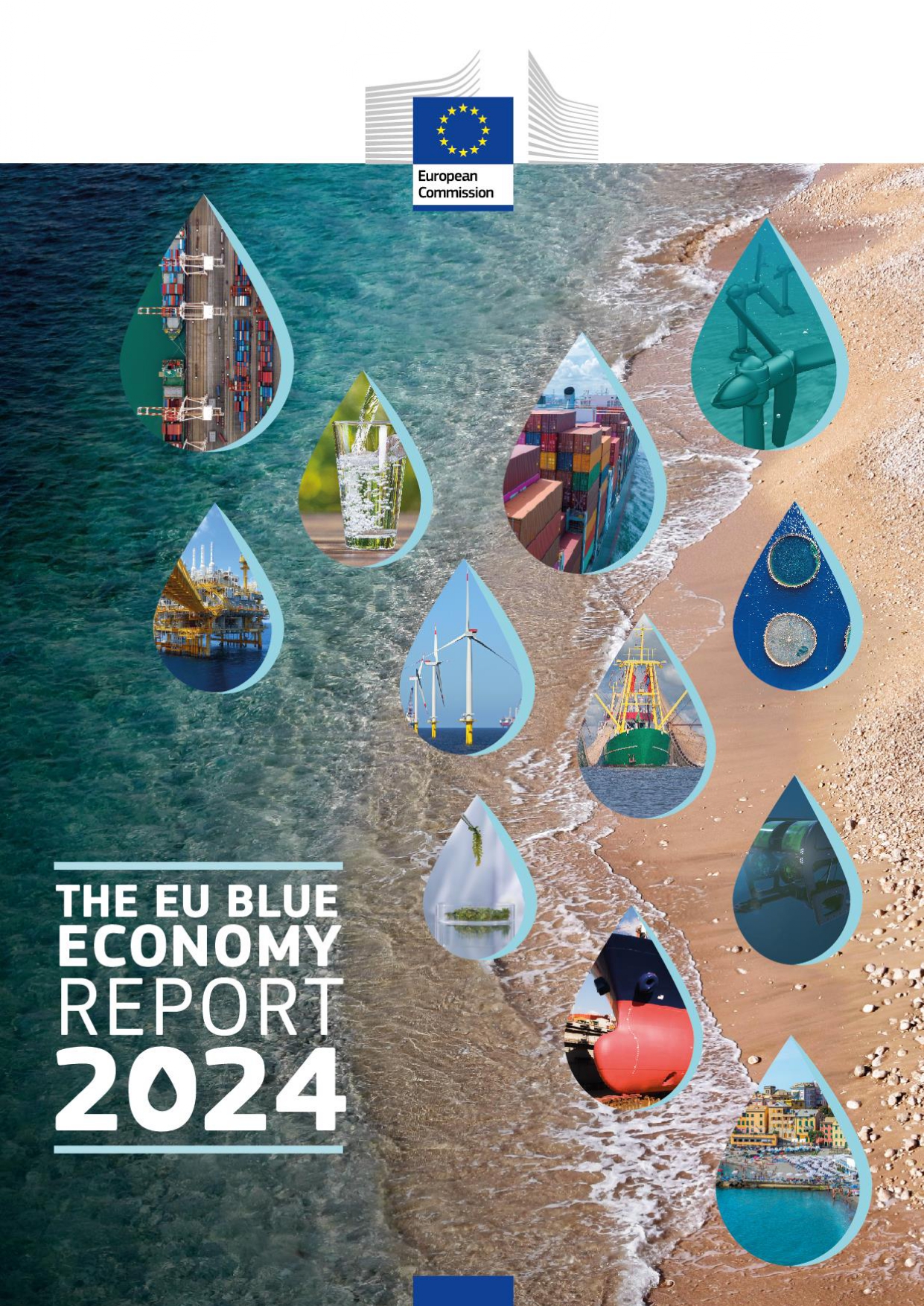
The 2024 edition of this annual report offers an in-depth analysis of European blue economy sectors. The report presents their performances based on the latest available data and their evolution since 2009, with a special focus on key socio-economic trends between 2020 and 2021. Furthermore, it delves into the contribution of all blue economy sectors to energy transition. Finally, it illustrates the potential impacts of climate change on the blue economy along the EU coastline, showcasing the need to raise current levels of coastal protection.
- Date released: 2024/05/30
See all JRC publications from 2023

This summary presents selected facts, figures and findings from the recent JRC report “Biomass production, supply, uses and flows in the European Union”. It informs policymakers on the trends in biomass supply and demand at EU level and notably on the increasing demand from both primary domestic production and secondary sources, putting pressure on ecosystems.
- Date released: 2023/11/07
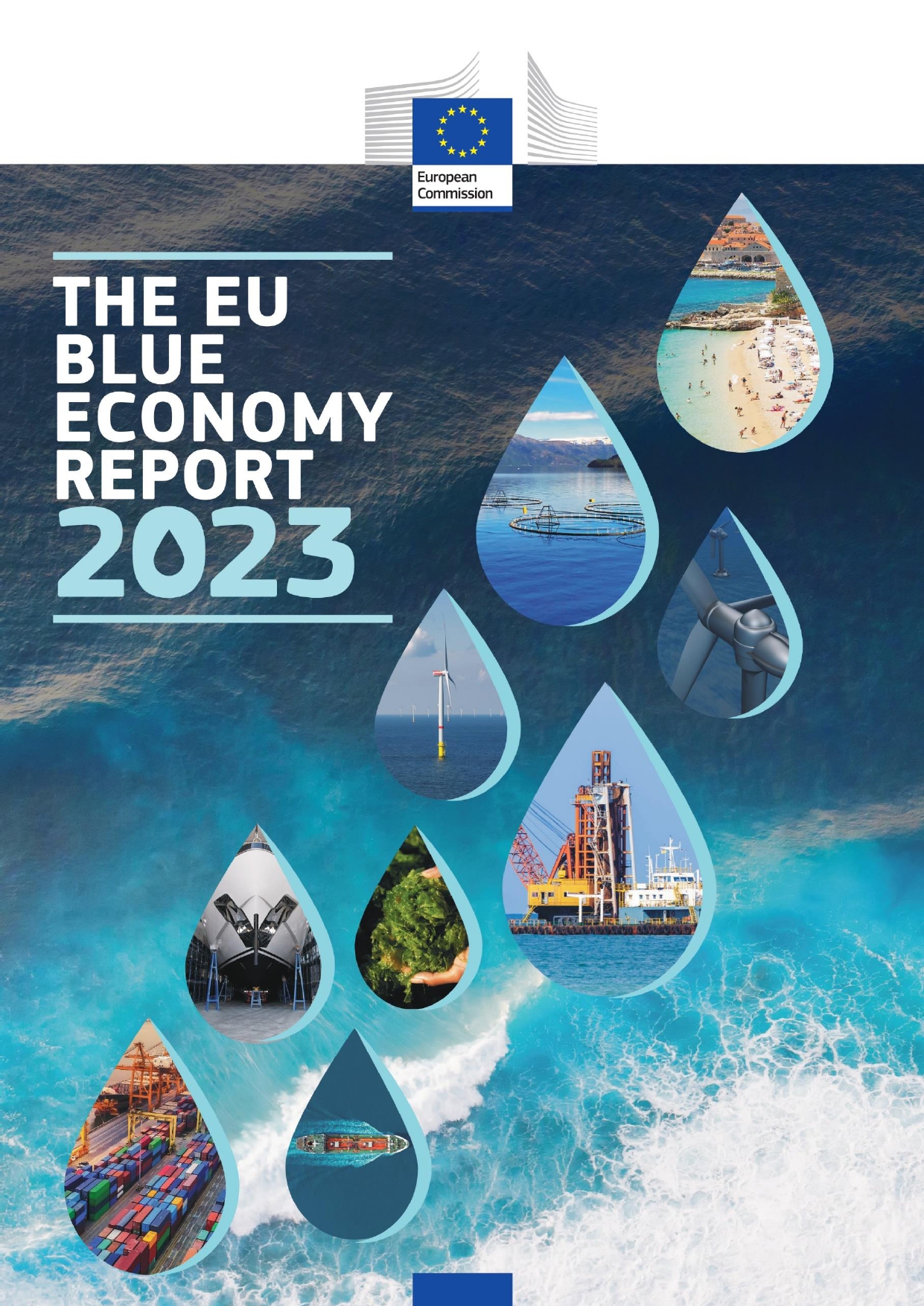
Jointly produced by DG Maritime Affairs and Fisheries (DG MARE) and the Joint Research Centre, the 2023 edition of this report highlights the evolution of the blue economy sectors since 2010. It shows that despite the negative impact of the COVID19 pandemic and the unprovoked Russian invasion of Ukraine, most of the analysed sectors increased their economic performances.
- Date released: 2023/05/23
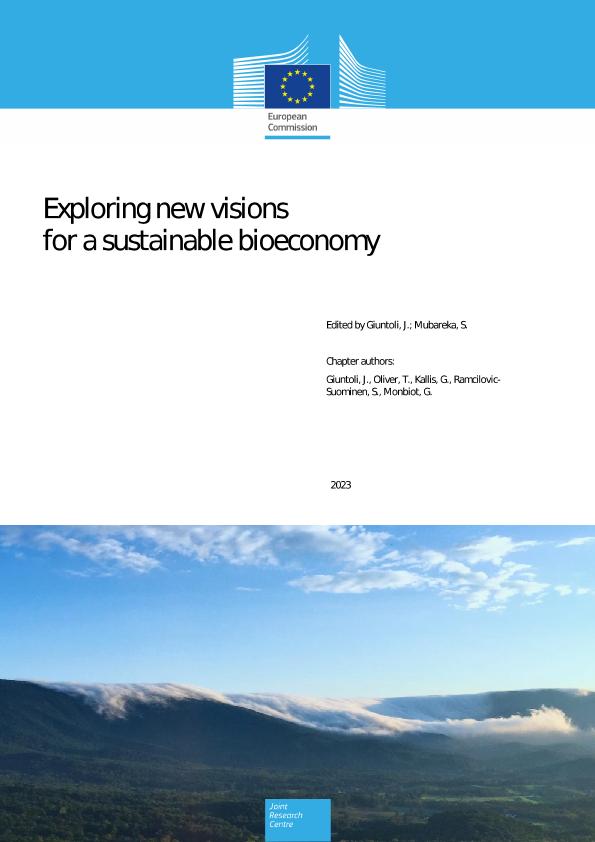
In this report, five authors share their perspectives on the existing narratives related to the bioeconomy, after discussions held at a workshop of the Community of Practice on Bioeconomy. The themes covered include: understanding human-nature relationship to frame the bioeconomy; facing the challenges of green growth; embedding the Environmental Justice agenda principles for a just bioeconomy; and the complexity of the agri-food system. The authors identify so far under-represented perspectives in the bioeconomy discourse, to develop an alternative vision for a “green, just and sufficient bioeconomy”.
- Date released: 2023/03/02

This scientific publication presents a Life Cycle Assessment-based Bioeconomy Footprint developed by JRC researchers to assess and monitor the environmental impacts of the EU bioeconomy along time. The study quantifies the overall impact of 76 representative products based on the consumption intensity and the environmental impacts of the life cycle of each of them.
- Date released: 2023/03/08

This science for policy report collects the contribution of 42 scientists from JRC and external organisations to provide a cross-sectoral overview of the biomass produced and used in the EU-27, as well as specific data on biomass production, supply, uses and flows by sector. It also dives into topics such as the trade of bio-commodities or some innovative wood-based products.
- Date released: 2023/02/27
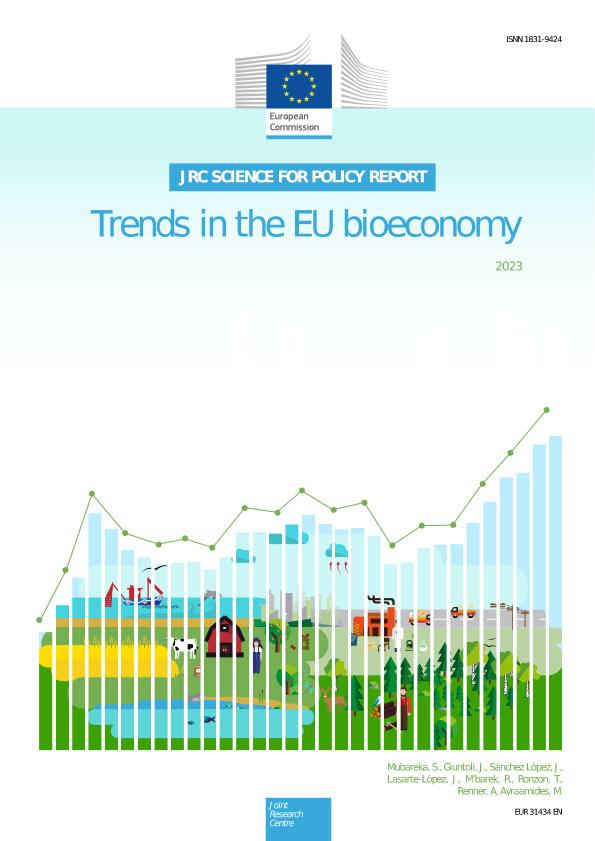
The EU Bioeconomy Monitoring System was by the JRC to track economic, environmental and social progress towards a sustainable bioeconomy. This publication reports the first assessment of the trends of the EU bioeconomy, based on the tracked indicators. The analysis shows that while resource efficiency is improving, there is a growing pressure on ecosystems from forestry and agriculture.
- Date released: 2023/02/24
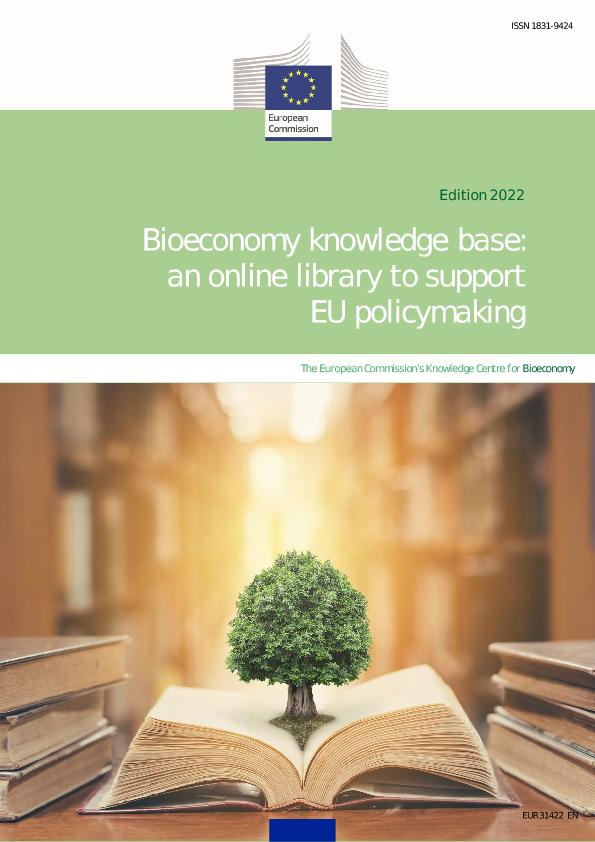
The Knowledge Centre for Bioeconomy online library provides a one-stop shop for filtered and distilled knowledge on the bioeconomy to support evidence-based EU policymaking. It is constantly updated with the latest publications, datasets, events, news, visualisations and other resources, and made publicly accessible. This report describes the workflow process and methods to curate, organise, store and share the bioeconomy-relevant knowledge.
- Date released: 2023/02/06
See all JRC publications from 2022
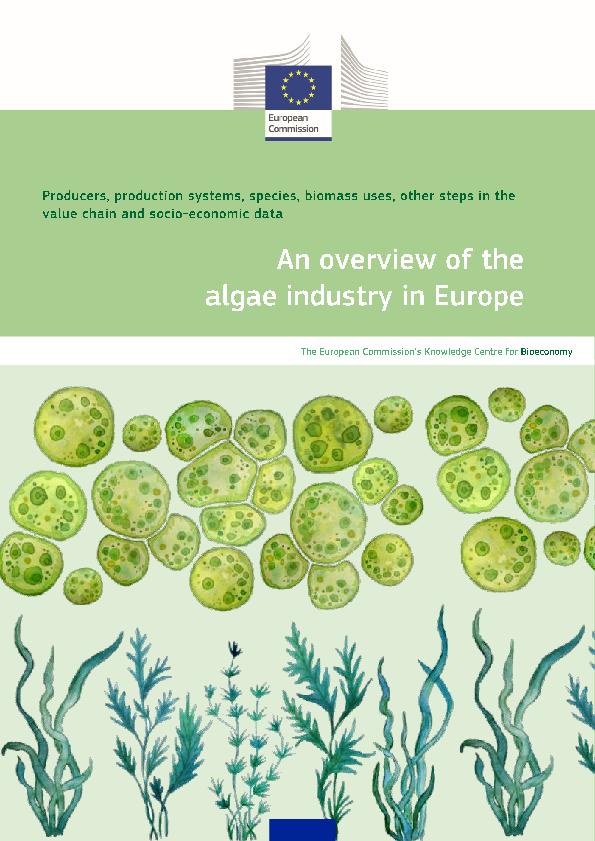
In this report, the JRC presents its updated database on algae, with recent data on algae production, novel socio-economic data and an extension to enterprises that are part of the post-production steps of the algae value chain. Based on these data, the report illustrates qualitative and quantitative aspects of the production and use of macroalgae, microalgae and Spirulina in Europe.
- Date released: 2022/10/03

A prospective Life Cycle Assessment (LCA) looks at future environmental impacts of technologies and their products, and is a well-suited methodology to assess the environmental performance of novel and emerging technologies for bio-based products, to ensure that such technologies present a genuine decrease of environmental burdens. This JRC report, based on discussions in a workshop of the Community of Practice on Bioeconomy, provides guidance on how to perform a prospective LCA for emerging bio-based products.
- Date released: 2022/11/18
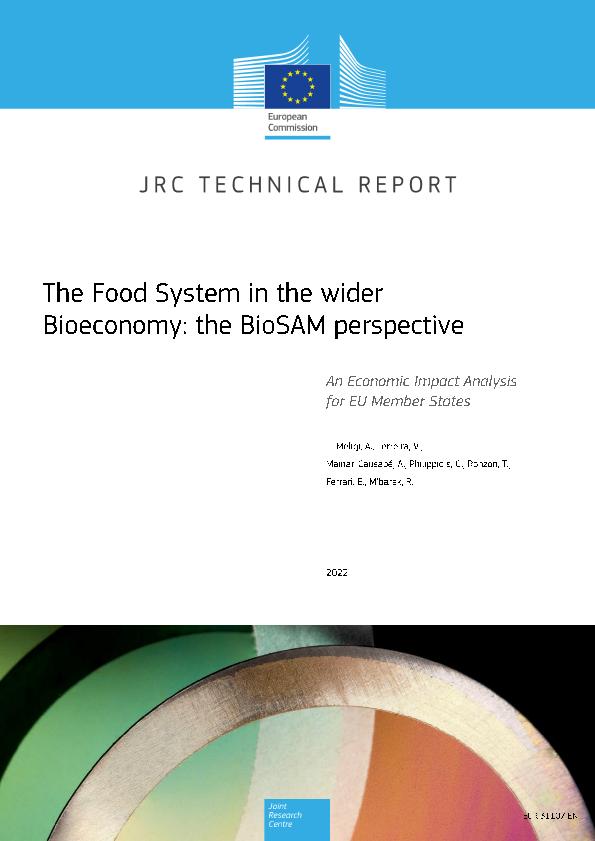
The purpose of this report is to present an overview of the European Union bio-based products and industries. The focus is mainly on the analysis of the impacts of final demand variation on value added and employment by sectoral level disaggregation. By using the the Bioeconomy Social Accounting Matrix (BioSAM) database it is possible to deepen the impact analysis by considering a detailed disaggregation of bio-based products. A country cluster analysis focusing on food system sectors is also introduced. In addition, the results are presented in a dashboard to allow the replication and comparison of different impacts by sector and country.
- Date released: 2022/06/08
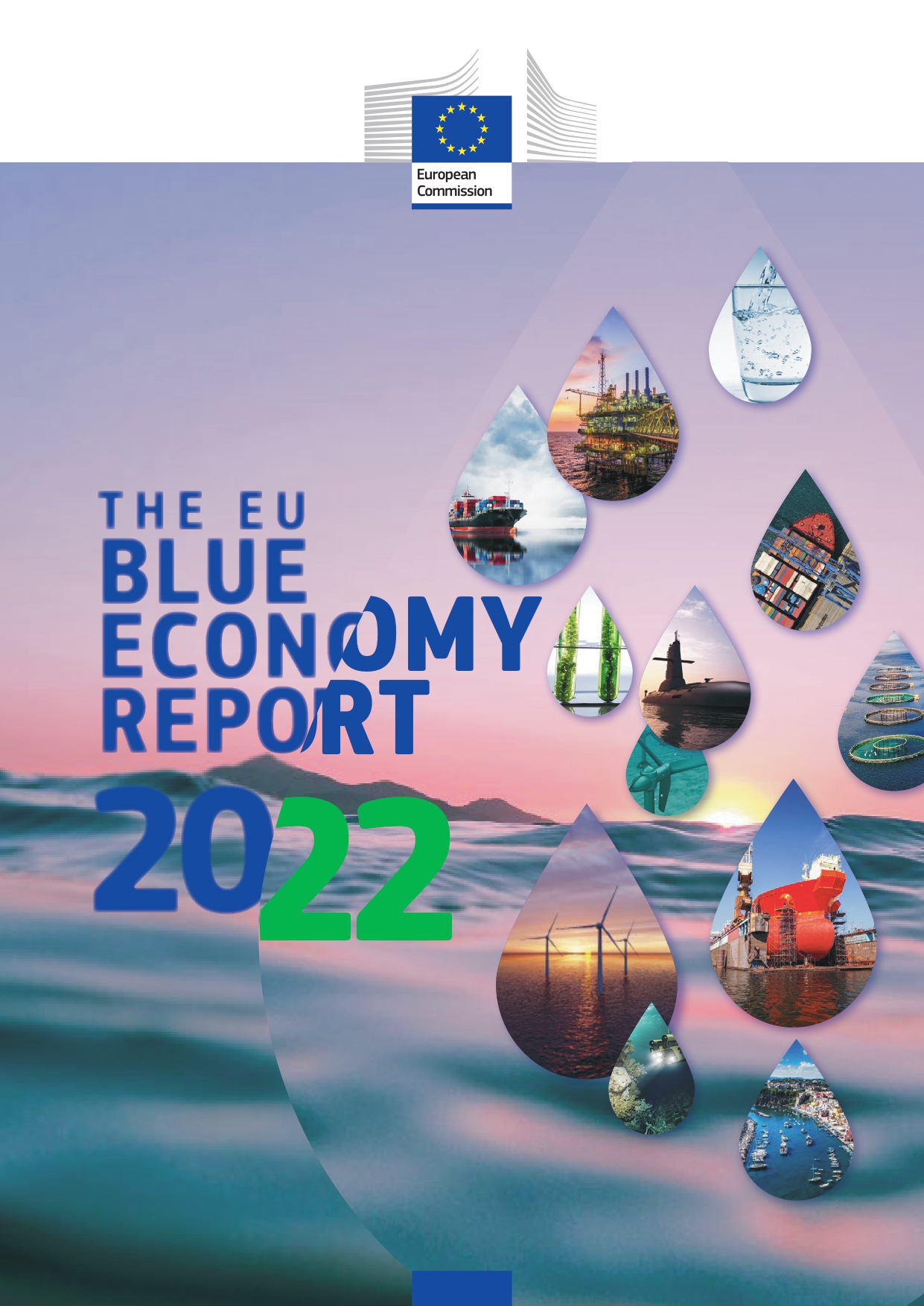
The fifth edition of the EU Blue Economy Report, published by the Commission, looks at the latest trends and developments in the economic activities that are marine-based or marine-related, including the blue bioeconomy sectors. It provides analyses for the EU-27 as a whole and by sector and industry for each Member State, to contribute to the assessment of the evolving contribution of oceans and coasts to the European economy.
- Date released: 2022/05/19
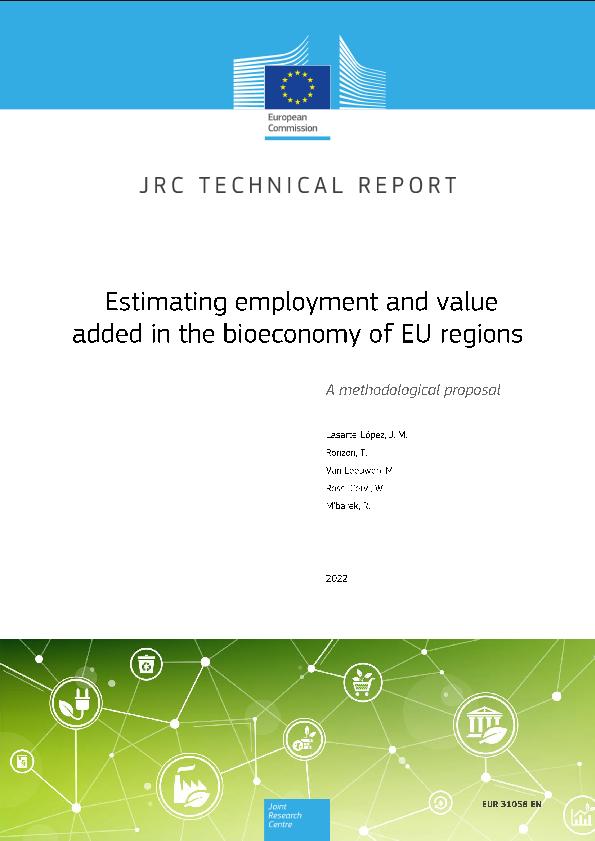
JRC researchers have developed a methodology to estimate the employment and value added of the EU bioeconomy at the regional level. The method uses existing data from the JRC and Eurostat and estimates the missing regional data from national statistics by applying various criteria, allowing the monitoring of major trends for EU regional bioeconomies. The report also highlights the main methodological challenges encountered and gives insights for future improvements.
- Date released: 2022/05/25
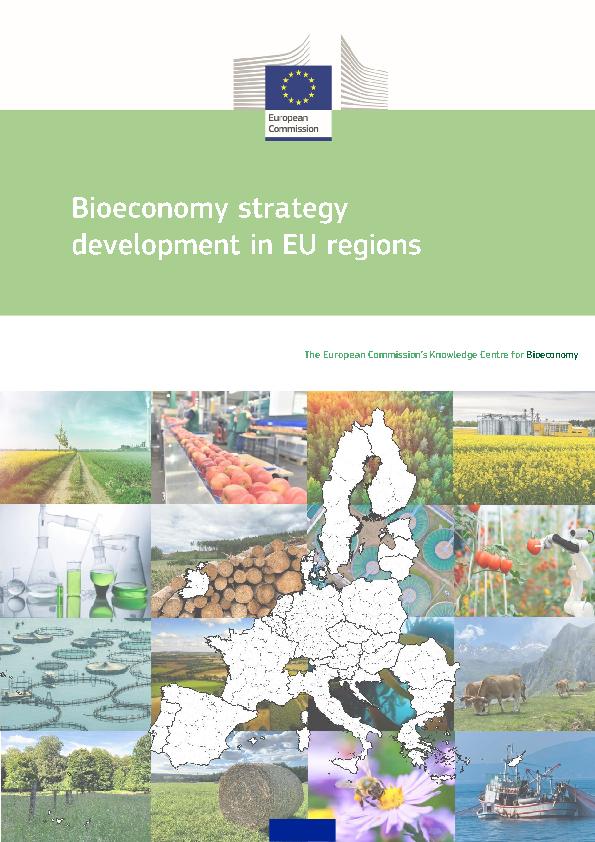
This report, elaborated for the European Commission’s Knowledge Centre for Bioeconomy, maps and analyses the deployment of bioeconomy strategies at regional level in the EU-27. The study covered regions at the territorial levels NUTS 1 and NUTS 2 and, in some cases, at NUTS 3 level, looking at different regulatory frameworks, different thematic coverage of the strategy, and different levels of development of the strategy.
- Date released: 2022/05/12
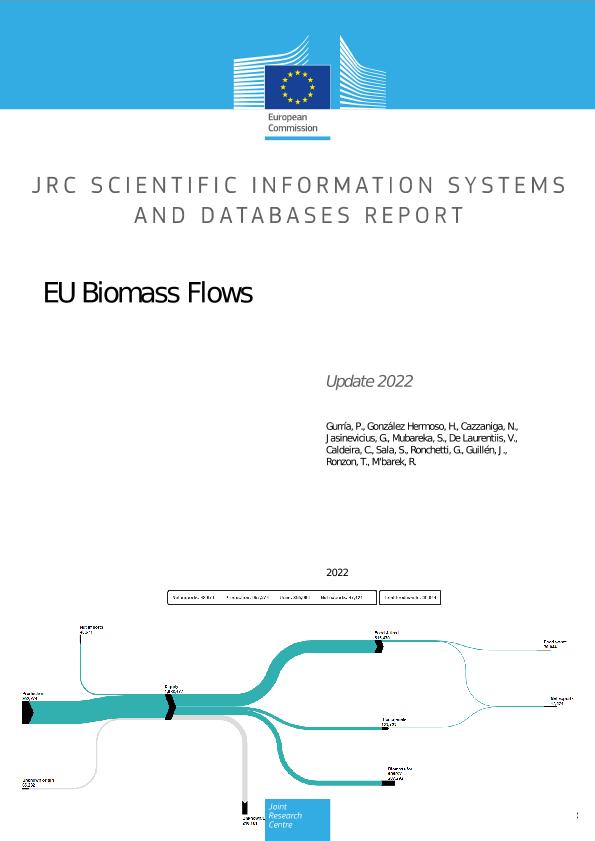
This report describes the 2022 release of the EU Biomass Flows tool, contributing to its biomass study. It is a visualisation, in the form of Sankey diagrams, of the flows of biomass for each sector of the bioeconomy, from supply to uses including trade. In addition to the updated data, novel features of this release include a redesign of the flows for woody biomass and integration of food waste flows.
- Date released: 2022/03/16

This JRC report accompanies the Sankey diagrams of woody biomass flows in the European Union for the years 2009-2017. Starting from primary sources of wood, removals or imports, wood can either feed wood processing industries for the manufacturing of wood-based products or be used for energy production. The woody biomass transferred across the different transformation steps and among the different subsectors follows complex flows, illustrated with the Sankey diagrams, where the width of each arrow is proportional to the magnitude of the flow.
- Date released: 2022/01/18

Currently, there is a general paucity of data available from respected secondary data sources for supporting the monitoring and evaluation of the performance of the EU bioeconomy. This paper represents an attempt to bridge that gap by employing varied sources, assumptions and data analysis techniques to examine the patterns of productivity growth and transition in the bioeconomy of the EU and its 27 Member States.
- Date released: 2022/06/08
See all JRC publications from 2021
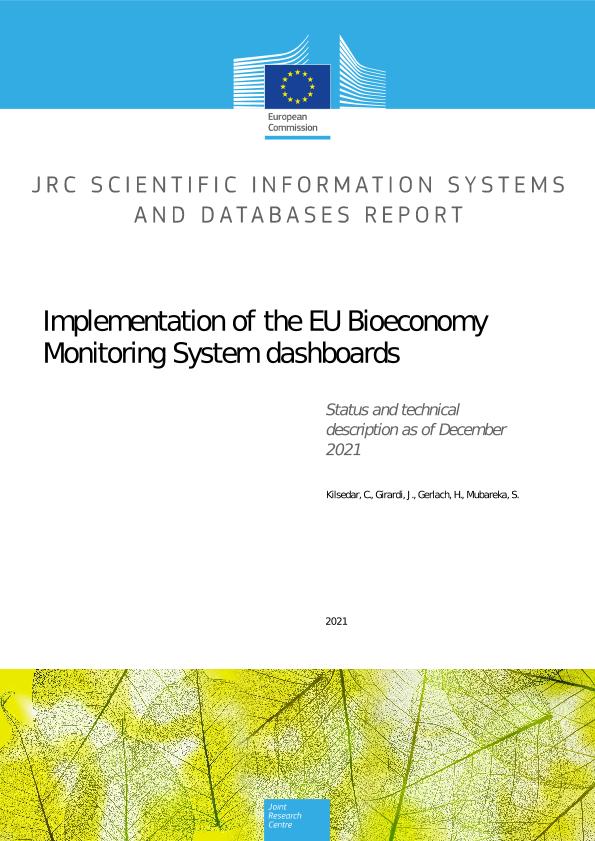
Following the EU Bioeconomy Strategy, the JRC, with the support of experts from Member States, has developed an internationally coherent monitoring system to track economic, environmental and social progress towards a sustainable bioeconomy. The EU Bioeconomy Monitoring System, hosted in the EC's Knowledge Centre for Bioeconomy platform, was officially launched in November 2020 and is in continuous improvement since then, with new features and enhancements. This report describes the progress made in 2021. It contains an overview of its current status, with technical details of the IT system, and future outlook.
- Date released: 2022/01/04
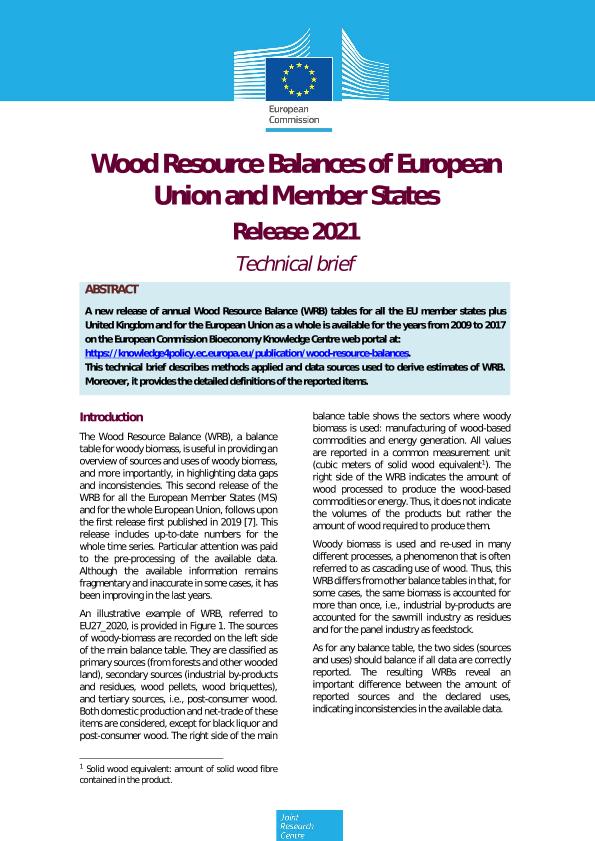
The JRC has published Wood Resource Balance (WRB) sheets of the European Union and each Member State for the years 2009 to 2017. The time series show a steady increase of woody biomass usage for both manufacturing and energy sectors in Europe. In addition, the resulting Wood Resource Balances always indicate a non-negligible difference in amount between the reported sources and declared uses of woody biomass, allowing analyses on gaps and inconsistencies.
- Date released: 2021/12/10

This document provides guidance to policymakers on how to monitor the sustainability of the bioeconomy in their country or within a macro-region, such as the European Union (EU). In any geographical context, the bioeconomy encompasses the primary production sectors (crop and livestock production, forestry, fisheries and aquaculture) and the ecosystems that supply the primary materials and services to these sectors.
- Date released: 2021/12/01
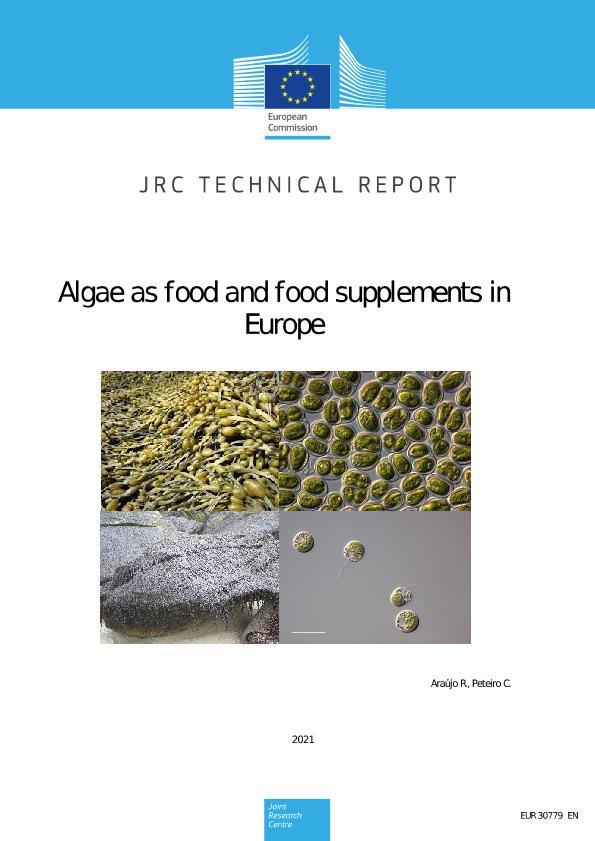
This technical report presents a comparative list of algae items (sensu lato) referred on the novel food catalogue, the Union list of authorized novel foods and official Member States’ lists of food and food supplements. Additionally, other algae food and food supplement items referred in available non-official lists are included. A final table merging all the information included in the official lists is presented following the most updated species taxonomic designation.
- Date released: 2021/08/04

This report presents a model which quantifies food waste at each stage of the food supply chain: primary production, processing and manufacturing, retail and distribution, food services, and household consumption. The food groups for which food waste is accounted for are sugar beet, cereals, fruit, vegetables, potatoes, oilseeds, meat, fish, eggs, and dairy. The model also estimates: food losses, by-products, and food consumed, which is compared with the results of nutritional surveys to perform a plausibility check of the model's results.
- Date released: 2021/07/05

The JRC has developed a structured and comprehensive methodological framework, referred to as the “Plastics LCA method”, which is described in this document. The Plastics LCA method provides detailed methodological and modelling rules to conduct LCA studies of plastic products based on a common and harmonised framework, with the ultimate aim of enabling as much as possible reproducible, consistent, robust and verifiable studies at the EU level.
- Date released: 2021/06/17
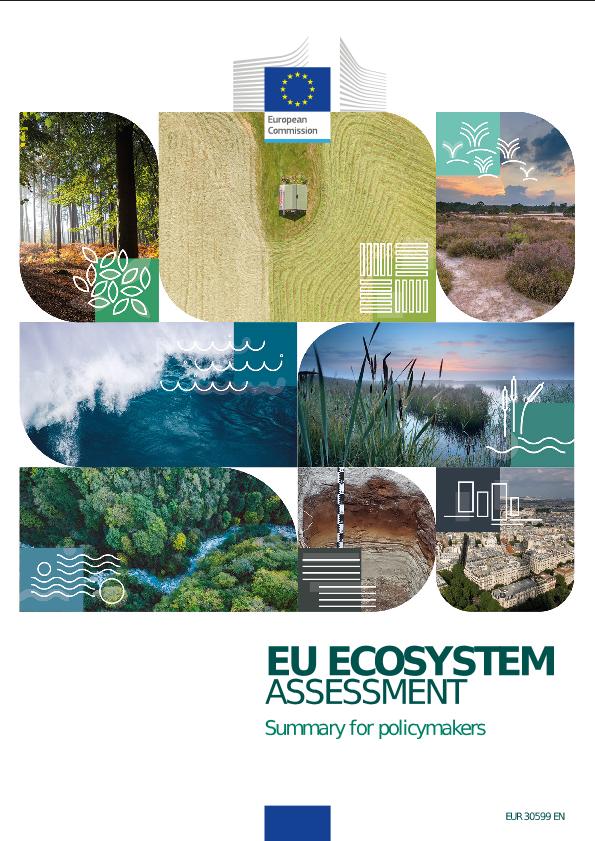
This ecosystem assessment extends and complements the knowledge we have about the state and trends of ecosystems reported under the EU environmental legislation. The conservation of habitats and species as well as the environmental ambitions on freshwater and marine ecosystems have a well-defined thematic and geographical scope. This assessment goes beyond covering the entire terrestrial and marine territory of the EU and in many cases provides more spatially explicit information.
- Date released: 2021/05/20
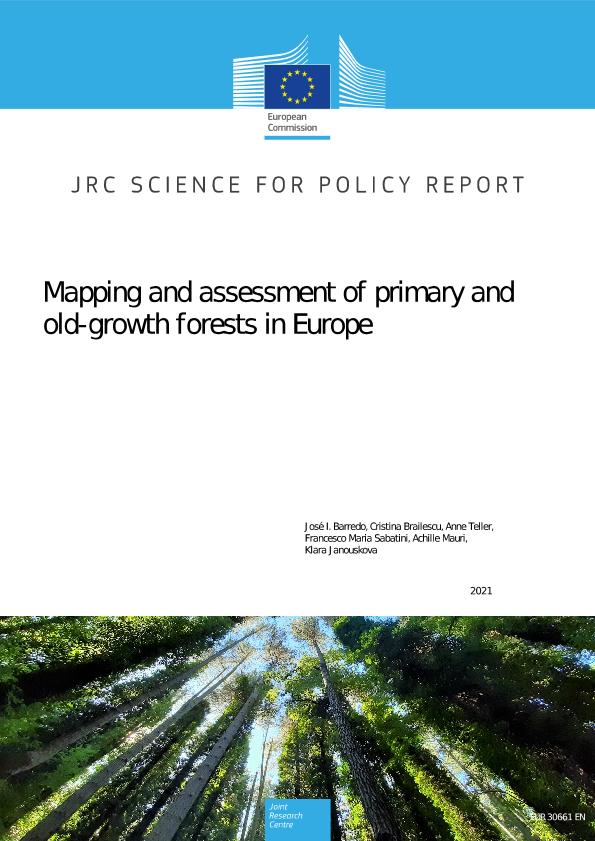
This report provides a knowledge base contributing to the process of developing guidelines for the definition, mapping, monitoring and strictly protecting all the EU’s remaining primary and old-growth forests. This process is coordinated by the Working Group on Forest and Nature (sub-group of the Coordination Group on Biodiversity and Nature), which brings together representatives of the forestry and nature conservation national authorities and relevant stakeholders.
- Date released: 2021/04/21

This report presents a database of chemical and material driven biorefineries in the EU and in selected non-EU countries. This work builds on the JRC database of bio-based industries and extends it by providing details on the value chains of biorefineries and by allowing international comparisons. The content of the database is presented through two online publicly accessible dashboards. he functioning of the interactive visualizations of the dashboards and some main insights on the presence and composition of this critical sector of the bioeconomy are presented.
- Date released: 2021/05/03
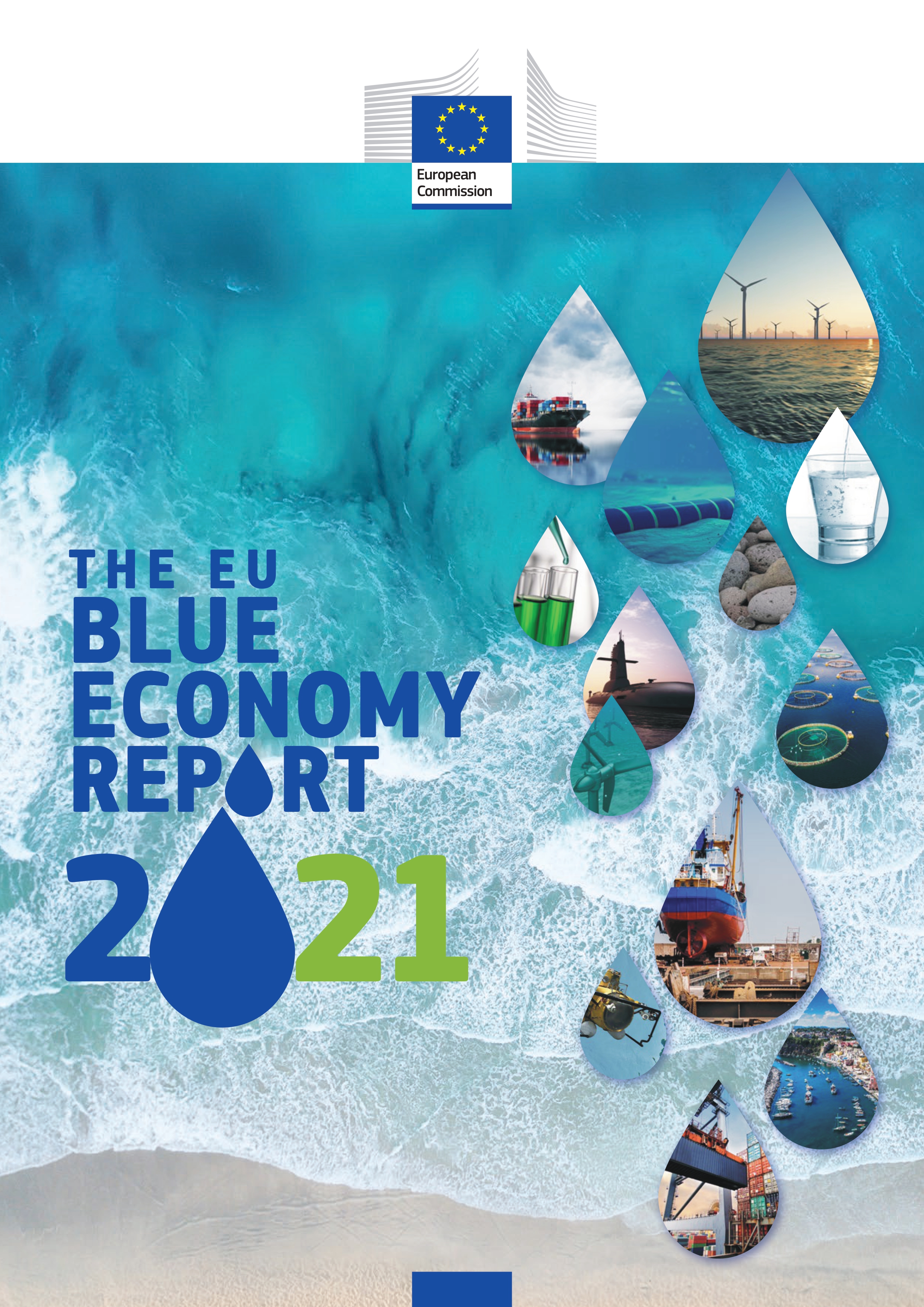
In its fourth edition, the yearly EU Blue Economy Report continues to analyse the scope and size of the Blue Economy in the European Union. It aims at providing support to policymakers and stakeholders in the quest for a sustainable development of the oceans, coastal resources and, most notably, to the development and implementation of polices and initiatives under the European Green Deal and in particular with the insight of the Sustainable Blue Economy communication.
- Date released: 2021/06/03
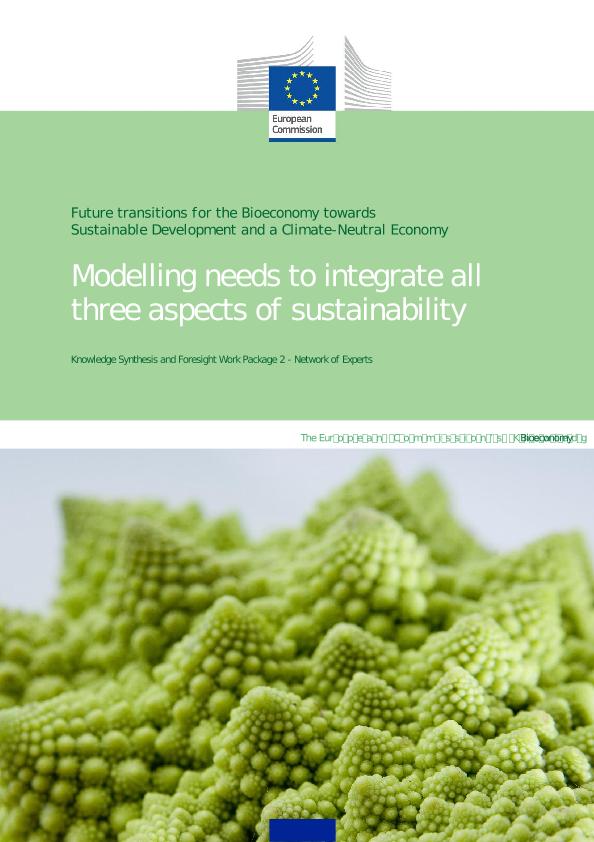
This report analyses the existing capacity and needs for bioeconomy modelling to integrate all three dimensions of sustainability (economic, social, environmental) and provides recommendations for developing new and improved models that are better suited to assist foresight activities and policy making related to the targeted transformation.
- Date released: 2021/04/30

This report presents the results of a collaborative foresight process which elaborated four scenarios for the future EU bioeconomy until 2050. It presents initial reflections on transition pathways gained from these scenarios in 2050, and insights for the future of the bioeconomy in Europe, and abroad, with a focus on implementing a circular, sustainable, and transformative BioWEconomy, not only in the EU, but globally.
- Date released: 2021/04/12
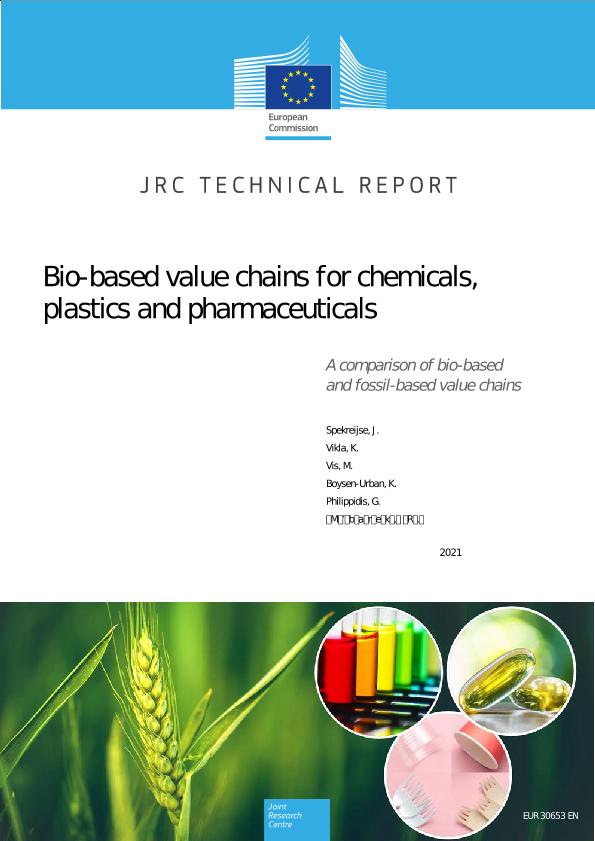
This report aims to contribute to a better understanding of bio-based chemicals, plastics and pharmaceuticals in comparison to its fossil-based technologies, selecting representative value chains for each of the categories. This information is also needed to feed forward-looking modelling tools with aggregated data, which serves as a starting point for simulating different medium- to long-term development pathways for bio-based innovations.
- Date released: 2021/03/30

Employing a combination of different data sources and plausible hypotheses, this paper seeks to overcome some of these data gaps, caused by an lack of a formal system of European data classification and collection, through the compilation of a meaningful set of market indicators for specific bio-based chemical activities and products. With limitations, the statistics presented have been used to carry out some first steps to monitor the performance of bio-based industries.
- Date released: 2021/03/31

The aim of this paper is to fulfil the need to develop a harmonised modelling system that enables the estimation of food waste generated by Member Sstates, by presenting two modelling approaches to estimate food waste in EU countries. One approach is based on Material Flow Analysis (MFA) and combines statistical information on production and trade of food products with food waste coefficients. The other approach is based on the estimation of food waste based on waste statistics.
- Date released: 2021/03/11
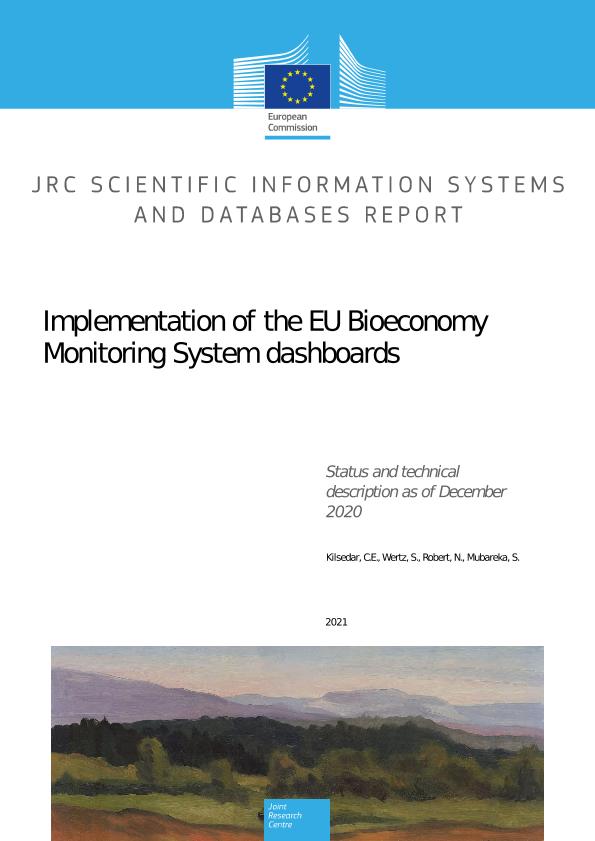
The EU Bioeconomy Monitoring System addresses the need for a comprehensive monitoring system by establishing a mechanism to measure the progress of the EU bioeconomy towards the five strategic objectives it tackles. It defines and implements a comprehensive monitoring framework for the EU bioeconomy, which covers environmental, social and economic dimensions of sustainability and relates to the overarching Sustainable Development Goals (SDGs) context.
- Date released: 2021/02/17
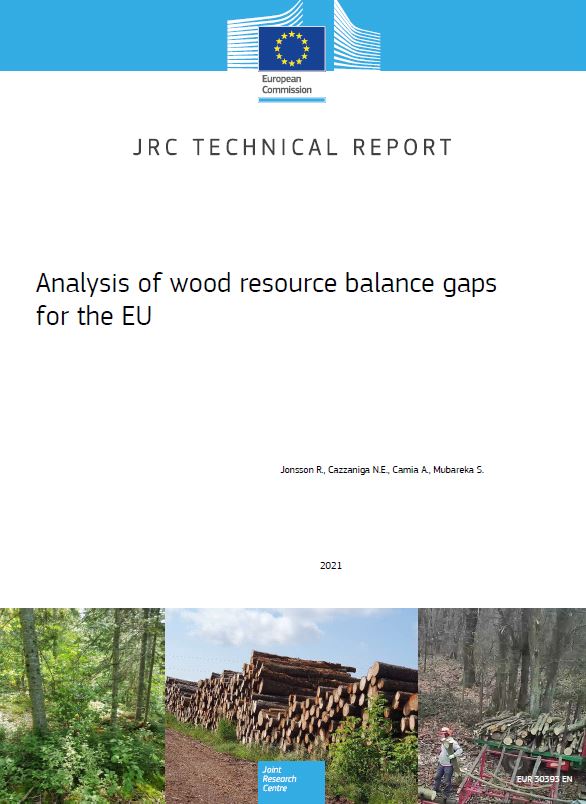
This technical report provides an analysis, on aggregated EU level, of Wood Resource Balance (WRB) sheets available at https://ec.europa.eu/knowledge4policy/publication/wood-resource-balances. Summing the WRBs of individual Member States, the amount of woody biomass used in manufacturing of wood-based products and for heat and power exceed the total reported amount of woody biomass sources for all available years.
- Date released: 2021/01/29
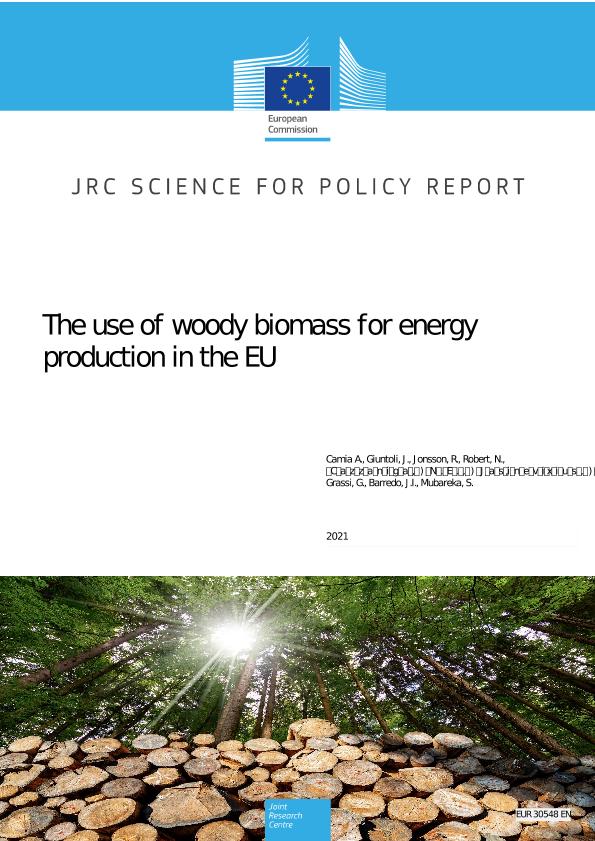
The purpose of this study is to further our understanding on whether or not woody biomass for energy can be produced, processed and used in a sustainable and efficient way to optimise greenhouse gas savings and maintain ecosystem services, all without causing deforestation, degradation of habitats or loss of biodiversity. This document covers the whole value chain of woody biomass, from the primary wood production, to the processing and uses of wood; to its re-use and end of life.
- Date released: 2021/01/25

This study adds to the scientific literature dealing with the climate change mitigation implications of wood substitution. Its main scientific contribution rests with the modelling approach. By fully integrating forest resource and wood-product markets modelling in quantitative scenario analysis, it accounts for international trade in wood products as well as impacts on EU forests and forest-based sector employment of an increased EU uptake of wood-based construction and/or biochemicals and biofuels.
- Date released: 2021/01/11
See all JRC publications from 2020

The Sankey biomass diagram represents the flows of biomass for each sector of the bioeconomy, from supply to uses including trade. The diagram enables deeper analysis and comparison of the different countries and sectors across a defined time series. In this document, the sources and data transformation steps to create the database used to represent these biomass flows is summarised, as well as the main data gaps and challenges encountered. The report presents the main features and functionalities of the new EU Biomass Flows tool and some insights based on the represented data and potential future research opportunities.
- Date released: 2020/11/27
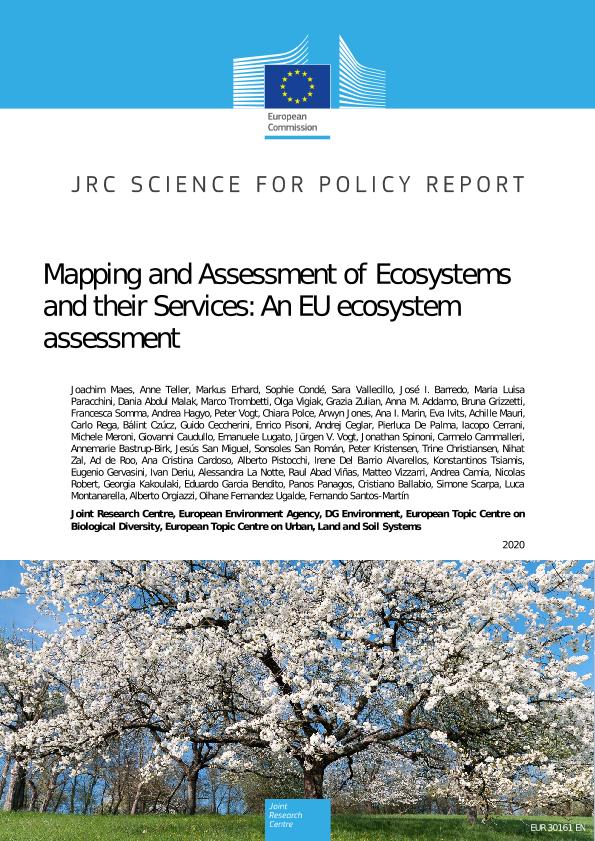
This report presents an ecosystem assessment covering the total land area of the EU as well as the EU marine regions. It also constitutes a knowledge base which can support the evaluation of the 2020 biodiversity targets and provides a data foundation for future assessments and policy developments, in particular with respect to the ecosystem restoration agenda for the next decade (2020-2030).
- Date released: 2020/10/12

The EU Bioeconomy Strategy, updated in 2018, in its Action Plan pledges an EU-wide, internationally coherent monitoring system to track economic, environmental and social progress towards a sustainable bioeconomy. This paper presents the approach taken by the European Commission’s (EC) Joint Research Centre (JRC) to develop such a system.
- Date released: 2020/07/29
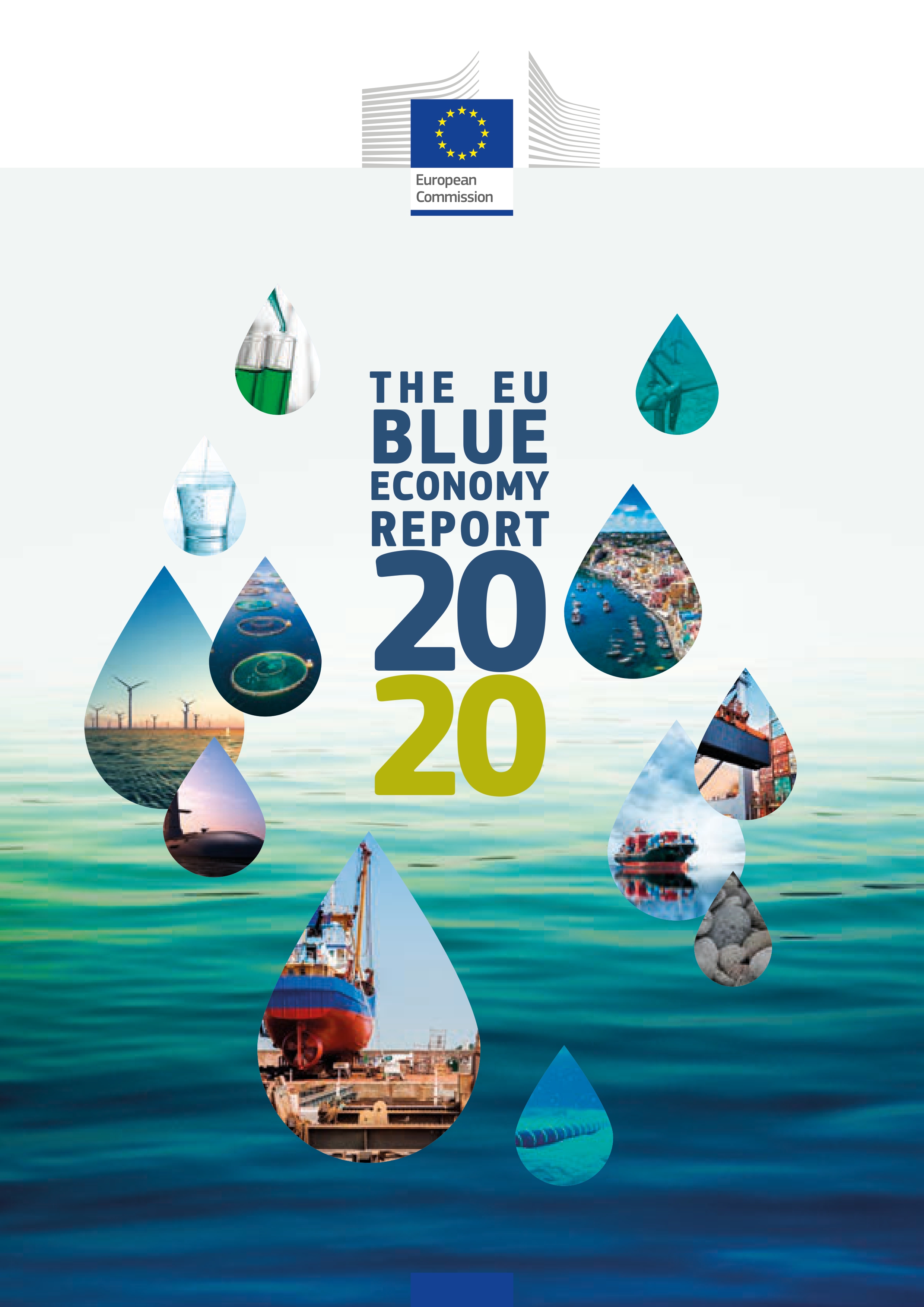
In its third edition, the EU blue economy report continues to analyse the scope and size of the Blue Economy in the European Union. For the first time, the report addresses the environmental dimension of the blue economy in detail, thereby also contributing to achieving environmental objectives. The report also looks at the economic value of several ecosystem services provided by the ocean, including habitats for marine life, carbon sequestration, and processes that influence climate change and biodiversity.
- Date released: 2020/06/10
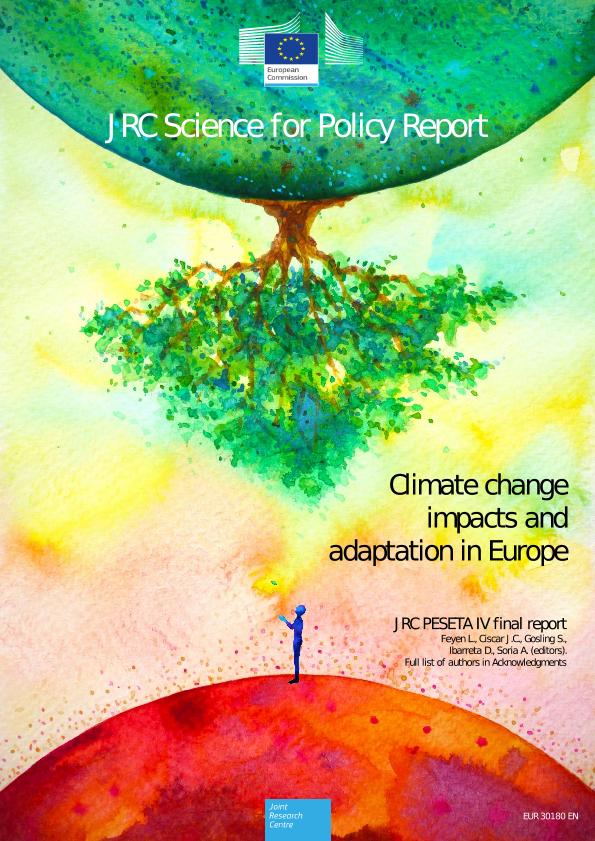
The JRC PESETA IV study shows that ecosystems, people and economies in the EU will face major impacts from climate change if we do not urgently mitigate greenhouse gas emissions or adapt to climate change. The burden of climate change shows a clear north-south divide, with southern regions in Europe much more impacted, through the effects of extreme heat, water scarcity, drought, forest fires and agriculture losses. Limiting global warming to well below 2°C would considerably reduce climate change impacts in Europe. Adaptation to climate change would further minimize unavoidable impacts in a cost-effective manner, with considerable co-benefits from nature-based solutions.
- Date released: 2020/05/13

The purpose of this report is to advance more objective and rigorous measurement and analysis of the bioeconomy according to the broad definition of the European Commission in 2018. The focus is mainly on the economic indicators, aiming at the inclusion of bio-based services derived from the symmetric input-output tables from the system of national accounts available from Eurostat and additional expert information.
- Date released: 2020/04/22

This document describes the first year of the development of the EU Bioeconomy Monitoring System by the European Commission’s Joint Research Centre (JRC), in collaboration with experts throughout European and International organisations, EU Member States, Commission Services and other stakeholders to assess questions such as those posed above. The framework is designed to house several basic indicators that are, analogous to the instruments of a symphony, in themselves useful and meaningful but whose value is enhanced once they are placed within an orchestra.
- Date released: 2020/01/23
See all JRC publications from 2019

In this study, model-based scenarios are built following the European Commission's Global Energy and Climate Outlook to 2050, which constitutes a central element of EU's vision for a prosperous, modern, competitive and climate neutral economy. Results of this study indicate that in the reference scenario (REF) economic growth in developing and emerging countries remains strong towards 2050, while global income disparities persist.
- Date released: 2019/11/18

This ex-ante study assesses the potential impacts on land use changes, and associated GHG emissions, in Brazil resulting from increases in EU demand for ethanol to 2030, and draws evidence-based conclusions to verify the compliance of sugarcane feedstock production with the REDII environmental criteria.
- Date released: 2019/10/16
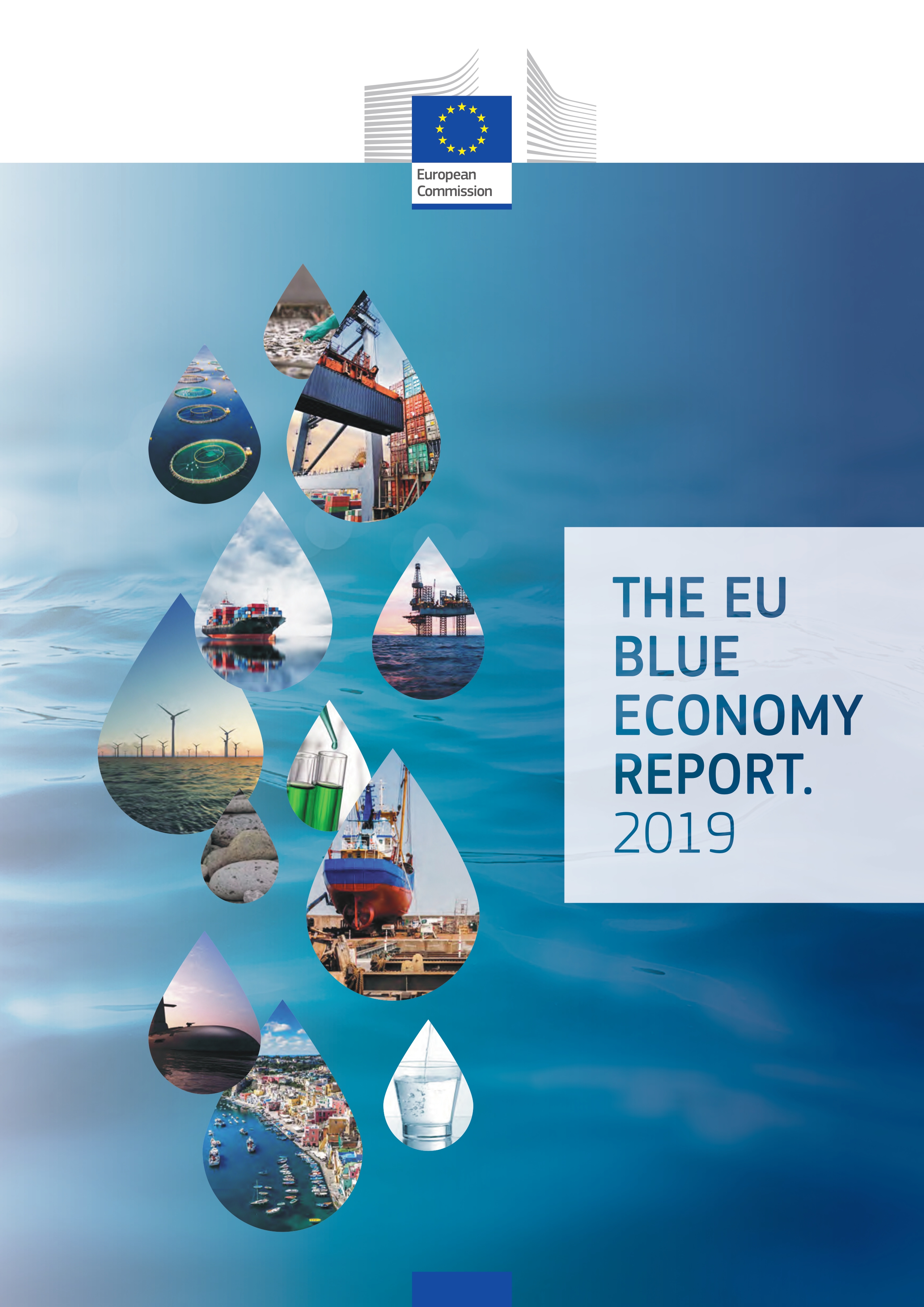
The EU Blue Economy Report analyses the scope and size of the blue economy in the European Union, solidifying a baseline to support policymakers and stakeholders in the quest for a sustainable development of oceans, sea and coastal resources. The second edition oft his report includes several improvements and new elements, such as a more detailed and extensive analysis on emerging activities, new chapter on natural capital and ecosystem services, and a regional analysis focusing on socioeconomic features.
- Date released: 2019/05/22
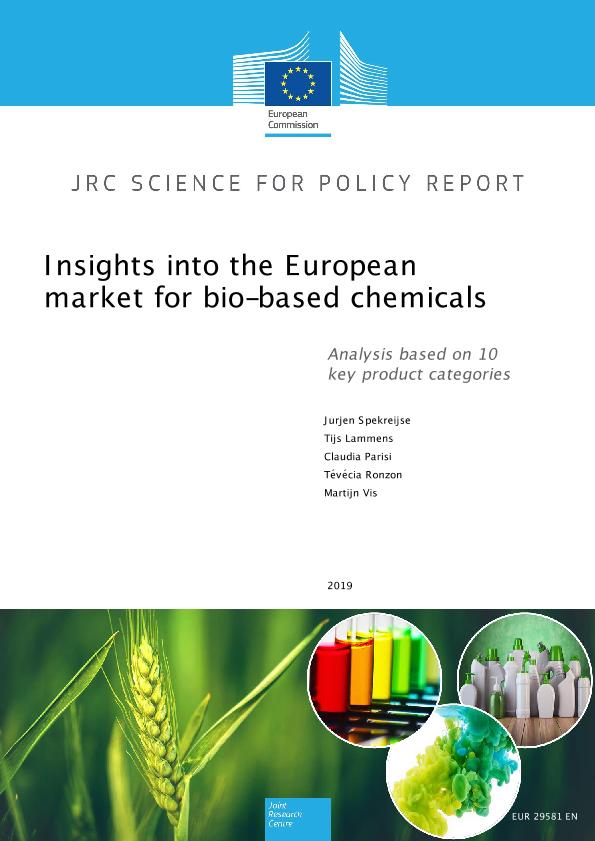
Bio-based products can bring new functionalities to the market and make the EU economy more sustainable. According to this analysis by JRC, based on ten key chemical categories, the EU produces 4.7 Mt/a of bio-based chemicals which represents a bio-based share of about 3.0%, although the market is diverse and large differences can be found between product categories.
- Date released: 2019/01/22

These factsheets have been prepared as part of the report "Insights into the European market for bio-based chemicals". For each bio-based chemical category described in the report, a factsheet has been produced, summarising the main results of the market study. Further details on the information provided in the factsheets, including underlying methods, sources and uncertainties, can be found in the main report.
- Date released: 2019/01/22
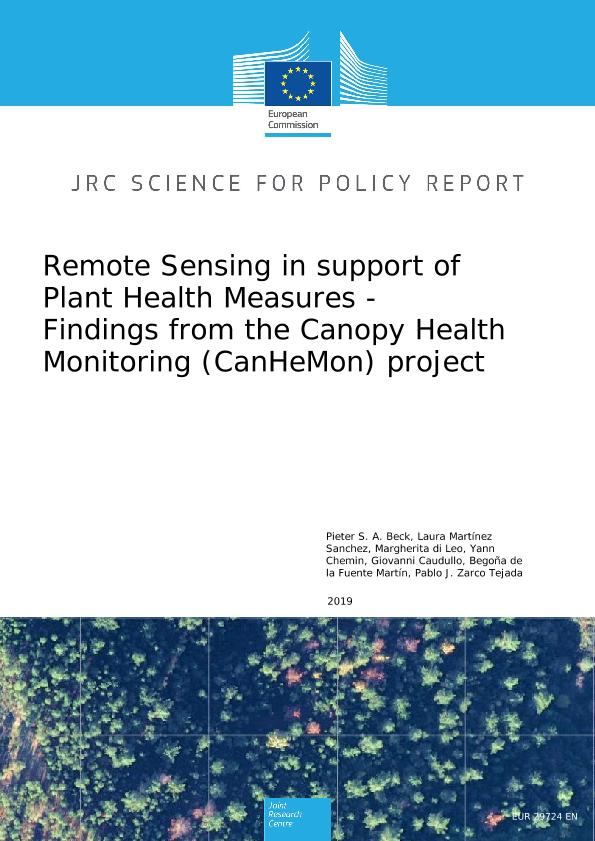
This report describes the main findings from the Canopy Health Monitoring (CanHeMon) project, which achieved the detection of ca. 19 000 individual declining coniferous trees through remote sensing, and an outlook on the potential future use of remote sensing in support of plant health measures.
- Date released: 2019/04/24
See all JRC publications from 2018

This brief summarises key information on the Bioeconomy in the countries of BIOEAST, a Central and Eastern European initiative for knowledge-based agriculture, aquaculture and forestry in the Bioeconomy (data as of 2015). This open initiative started by the Visegrad Group Countries: Czech Republic, Hungary, Poland, Slovakia, who were subsequently joined by Bulgaria, Croatia, Estonia, Latvia, Lithuania, Romania, and Slovenia.
- Date released: 2018

The report delivers an assessment of EU biomass production, uses, flows and related environmental impacts for the sectors agriculture, forestry, fisheries and aquaculture, and algae. Quantitative estimates are derived from available data and current knowledge, yet highlighting the uncertainties and the remaining gaps. The work is framed within the JRC biomass mandate and is meant to support the EU bioeconomy and the related policies.
- Date released: 2018/02/21
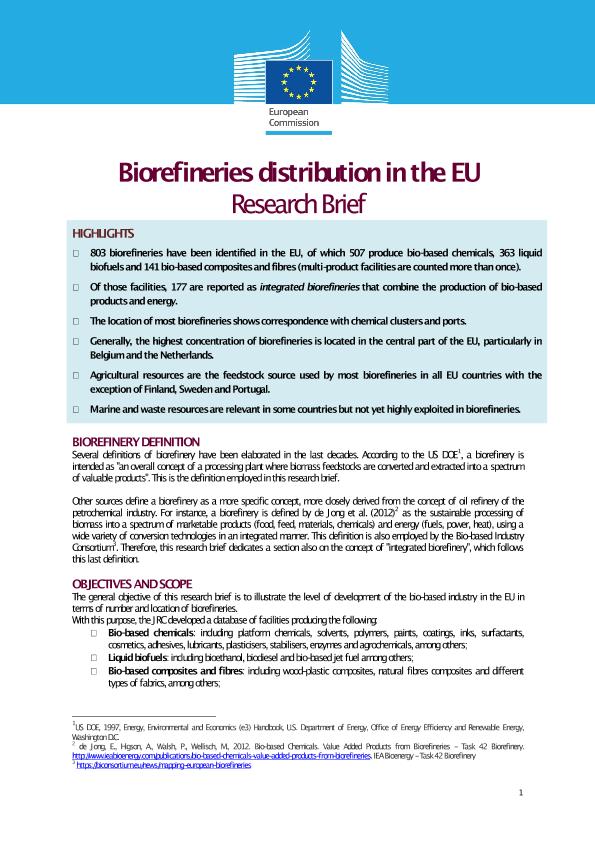
The general objective of this research brief is to illustrate the level of development of the bio-based industry in the EU in terms of number and location of biorefineries. With this purpose, the JRC developed a database of facilities producing (i) bio-based chemicals; (ii) Liquid biofuels; (iii) Bio-based composites and fibres; (iv) other types of energy from biomass. The final database includes biorefineries at different Technology Readiness Level.
- Date released: 2018/02/21

This report covers the background of the survey done in 2017 in order to collect information on bioeconomy strategies or policies in the EU Member States and other countries, and provides an overview of other related initiatives, documents the methods used and concludes with recommendations for future editions of this survey.
- Date released: 2018/09/26
See all JRC reports in the KCB library
KCB visualisations
Expand the accordions to view various visualisations representing key data and information regarding the EU bioeconomy.
- EU Biomass Flows (2025): This diagram is a compilation of harmonised data from the various units contributing to the Biomass project. Shows data from 2008-2022.
- Spatial distribution of biomass production (2022): These maps present the spatial distribution of cop residues estimates, in kt of dry matter, per 25km across EU for the average period (2016-1020).
- Agricultural biomass production per Member State (2022): These charts present which Member States produce the largest amount of agricultural biomass (economic production and residues) by crop group and specific crop.
- Bio-based industry and biorefineries in the EU (2022): This dashboard presents the distribution of the bio-based industry (and biorefineries) in the EU, including the following production: bio-based chemicals, liquid biofuels, bio-based composites and fibres, biomethane, pulp&paper, sugar, starch and timber
- Interactive diagrams of woody biomass flows (2022): This Interactive Sankey diagrams shows the woody biomass flows at EU Member State level, as well as at EU-27 aggregate level, for the years 2009 to 2017
- Bioeconomy employment and value added (2022 data) (2025): The infographic provides updated data on employment and value added of the European bioeconomy from 2012-2022.
- Bioeconomy employment and value added (2021 data) (2024): The infographic provides updated data on employment and value added of the European bioeconomy.
- Infographics on biomass sources and uses in the EU-27 (2017 data) (2023): These infographics show how much biomass, in dry matter, is sourced from different primary and secondary sources and used for food, feed, materials and energy as well as recent trends in biomass uses and in the recovery of bio-waste.
- Bio-based textiles in Europe (2025): An explanatory video that explores the European textile industry and examines the key factors necessary to scale up the production of bio-based fibres.
- Brief on jobs and growth in the EU bioeconomy (2024): An explanatory video describing how the bioeconomy and biomass producing and converting sectors contribute to the economy of the EU and its Member States.
- Are you looking for ways to prevent consumer food waste? (2024): An explanatory video offering suggestions from the European Consumer Food Waste Forum (ECFWF) to help individuals reduce food waste, whether at home or elsewhere.
- The role of the forest-based bioeconomy in mitigating climate change through carbon storage and material substitution (2022): An explanatory video on collected information about the role of the forest-based bioeconomy in mitigating climate change through carbon storage and material substitution in Europe.
- The fisheries & aquaculture biomass in Europe (2021): An explanatory video on collected information about Fisheries & Aquaculture biomass in Europe.
- The algae biomass in Europe (2021): An explanatory video on collected information about Algae biomass in Europe.
- Life Cycle Assessment (LCA) to evaluate environmental impacts of Bioeconomy (2021): An explanatory animation on the use of Life Cycle Assessment (LCA) to evaluate environmental impacts of the Bioeconomy.
- A sustainable bioeconomy for Europe: strengthening the connection between economy, society and the environment (2021): An explanatory video about the European Bioeconomy Strategy and the priorities of the action plan in acheiving the goals of the Bioeconomy strategy.
- The agricultural biomass in Europe (2020): An explanatory video on collected information about agricultural biomass in Europe.
- Forestry biomass for a sustainable and circular Bioeconomy (2020): An explanatory video on collected information about forest biomass in Europe.
- The EU bioeconomy monitoring system (2020): A video introducing the new EU Bioeconomy Monitoring System developed to track the bioeconomy’s progress towards environmental, societal and economic sustainability in the EU and its Member States.
See all resources that help contribute to the KCB knowledge base.
KCB newsletters
| Originally Published | Last Updated | 21 Aug 2020 | 21 May 2025 |
| Related organisation(s) | JRC - Joint Research Centre |
| Knowledge service | Metadata | Bioeconomy |
| Digital Europa Thesaurus (DET) | bioeconomybiomassbio-based productresearchpolicy analysisforestAgricultureaquacultureblue economyIndicatorMonitoringLife cycle assessmentcircular economyFoodfood wasteforesightsustainable development |
PUBLICATION | 12 May 2025
Potential and limitations of machine learning modeling for forecasting Acute Food Insecurity
Acute Food Insecurity (AFI) remains a significant and persistent challenge, and Machine Learning (ML) offers promising solutions to improve predictions and early warning systems. ML...
PUBLICATION | 21 May 2025
The constitutional roles of local governments in the agriculture and rural development sector
This publication sheds light on the implementation status, along with challenges and opportunities in rural development across Lumbini, Karnali and Sudurpashchim provinces of Nepal.
NEWS | 21 May 2025
#LIFEis33: celebrating a third of a century of green innovation
The LIFE programme is today marking 33 years of supporting projects to make Europe a more sustainable and healthier place for people and nature.
Share this page
Was this page useful?

